#It’s so late 90s early-mid 2000s
Text
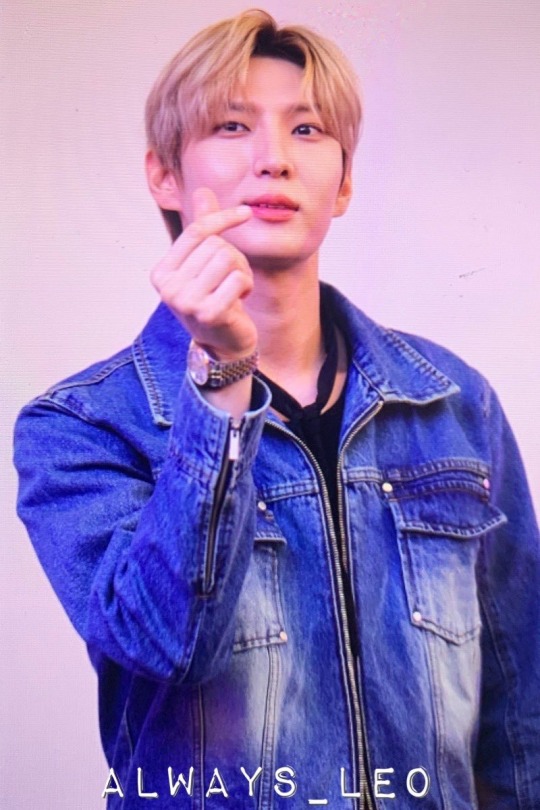
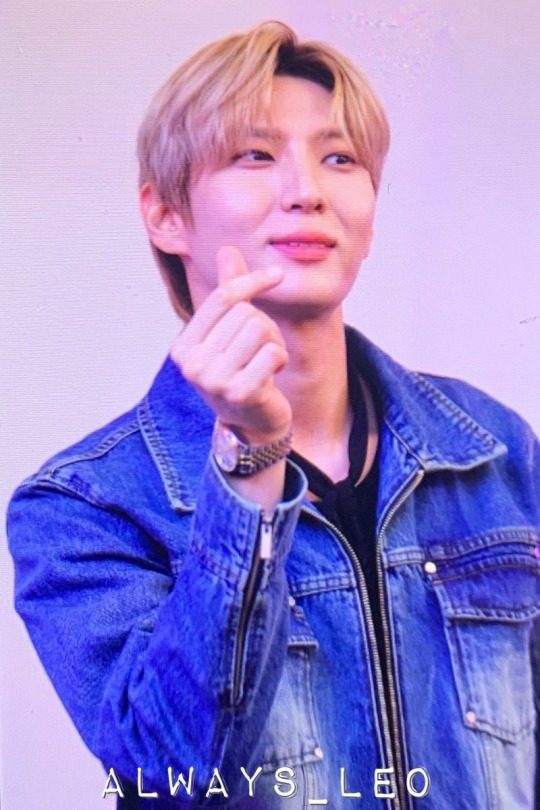
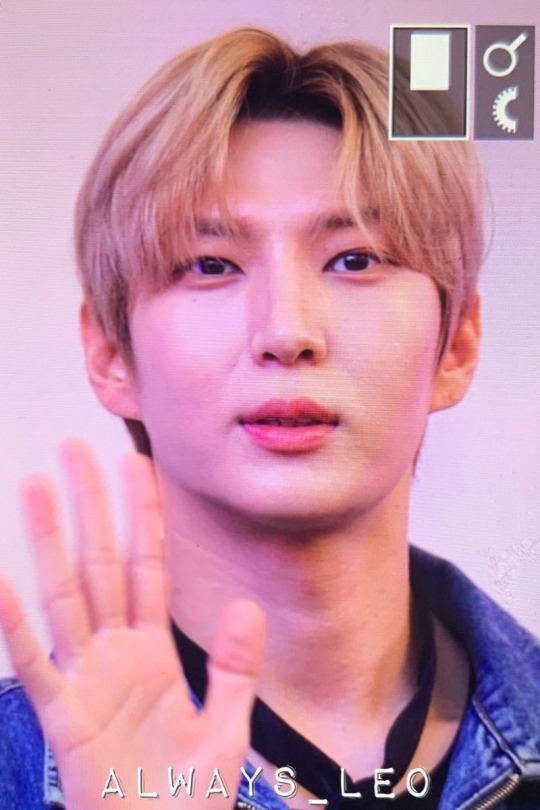
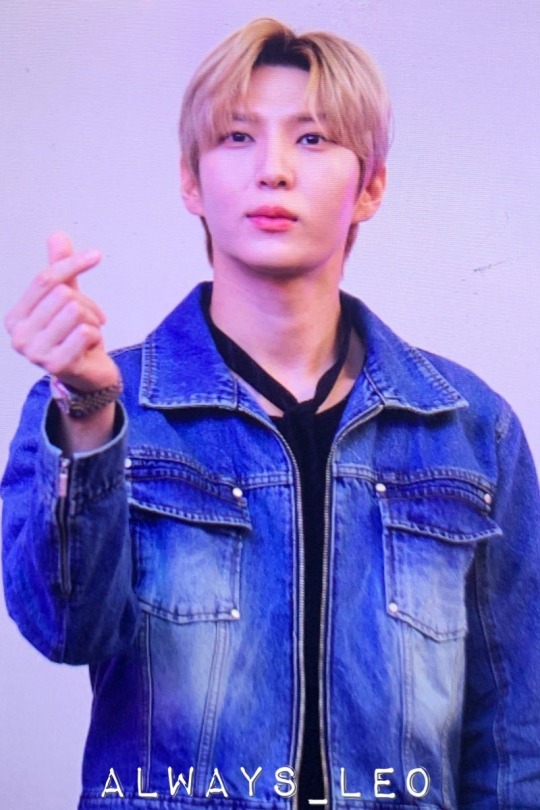
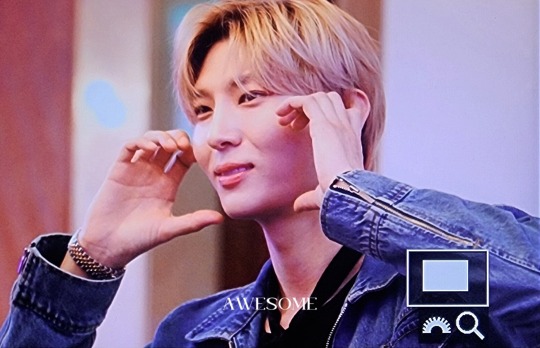
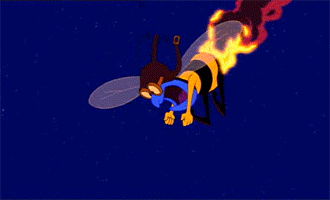
#amazing#I’m in love#gloriously round#he looks sooo good OFC HE DOES..#I like he’s kept it a darker blonde it’s more honey toned#I also like his roots are darker#from one blonde to another HES FAR SUPERIOR!!!#denim jacket and black jeans!!#no my mistake it’s trousers#I used to dress/have an outfit that looked like that then I went all black lollll#It’s so late 90s early-mid 2000s
12 notes
·
View notes
Text
everyone else might already know this but i just think it’s funny that canonically The Cage takes place in 2254, so over 10 years before the start of Kirks first 5 year mission as captain. while SNW takes place around 2258-2260
(with the reveal of Carol Marcus being pregnant it would make most sense for it to be 2259 seeing as TSFS takes place in 2285, which would make David Marcus 25 at the time that movie takes place)
anyways, then the beginning of TOS is in 2265, and here’s a visual representation of why i find that funny (using spock as an example because he’s my favorite)
Spock and Pike circa 2254

Spock and Pike circa ~2258

and then back to Spock looking like this in TOS circa 2265 (Where No Man Has Gone Before was the second pilot but The Man Trap aired first so idk which takes place first in canon so here’s both)
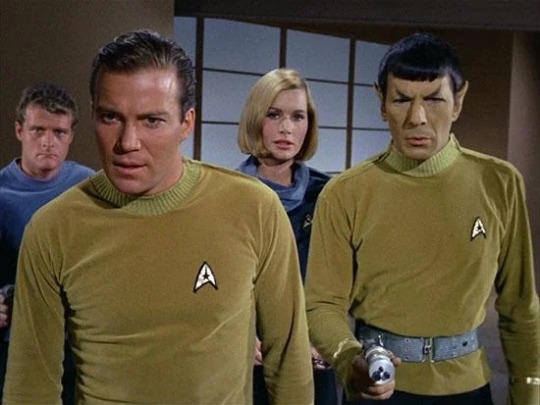
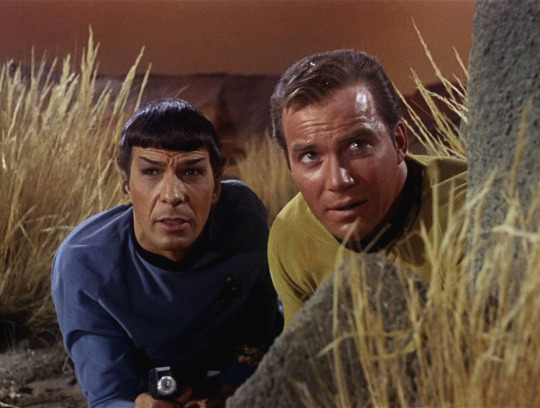
also i know most people are probably just gonna ignore it but i would love to see an in-universe explanation for why the hair and clothing styles changed so much between snw and tos.
#star trek#star trek tos#spirk#tos spirk#tos spock#tos#spock#leonard nimoy#star trek snw#like in star wars there’s an in universe reason for the prequels being so much crisper than the original trilogy#i don’t know the whole explanation but star wars is my brothers special interest so i know some#i like the movies im just not all into it#anyways it’s be cool if the explanation was just that our modern 10-20 yr fashion cycle held up#like we had late 60s to mid 80s we’re all big hair and bright colors#then the late 80s to mid-late 90s were muted grungy styles#then back to bright and fun and show as much skin as you can in the 2000s#then the fashion cycle started to speed up because of fast fashion#so then the 2010s were more conservative business casual vibes (still bright colors tho)#and then late 2010s to early 2020s it’s been a way more rapid fashion cycle#anyways i’m done ranting about fashion now i think
118 notes
·
View notes
Text
Lucy in my FT au!!

(Text closeup under the cut :3)

#fairy tail#lucy heartifilla#fairy tail fanart#modern au#ft modern au#fairy tail modern au#it’s set in the late 90’s to early-mid 2000’s so I can have some freedom#I will end it all if this Flops#nalu#my art
31 notes
·
View notes
Note
hiii 👀 can you a give a brief bio for each of your teenage pvz OCS? i don't know much Abt them 💥
OH YEAH!!!! let me just say it's NOT going to make sense, any of it, it's kinda like tf2 (As in, you can add as much bullshit as you want and it will still make sense lmfao)
betty - or by her full name, beatrice, is the child of electric boogaloo and my oc dazzling starr. with a talent for playing the drums and fashion. a total grunge/riot grrrl. bisexual disaster. dating jules. she gets her father's electricity powers and a bit of her mom's music powers. daddy's girl. rlly likes to sew as well!! most of her clothes are DIY she made out of junk or upgraded
paul - betty's twin brother, full name, paul lee. hes very talented in chemistry and biology. he also likes to play acoustic guitar and sometimes even banjo. just like his sister, he rlly likes fashion too and is NOT going to walk in some trash, even if he's a zombie. he's a mama's boy on the other hand and he gets more of dazz' powers.
jules - by her full name, julianne, science girl from the neighborhood with the highest GPA/best grades in the whole school/z academy. a snarky filipino with love for alternative rock. she's the vocalist in betty's band, hex graves. also loves skateboarding a lot, and watching old anime (her fav is sailor moon and revolutionary girl utena) she's also M.D. Livings' niece and he loves her dearly even if he's mf medic tf2 zombified. huge lesbian.
cass - full name, cassandra, chilean jock who loves a good game of sports, but loves filmography way more. she likes to make experimental films by herself with the help of her besties. she also has 2 moms she got adopted by :] she plays the guitar in the band. her music taste is like early 2000s punk rock/pop punk. pansexual and dating graham.
harper - actually named hajnal, as she's part hungarian, but prefers her nickname. the zompire coming from a family of aristocracy but hates it. doesn't like to be put in 16th century dresses and prefers to dress like an emo kid straight from the 2000s; the same for her music taste. my chemical romance is her unlife. she can and WILL fashion police everyone. also a huge fan of sculpting and art (she has mary sue ocs). aroace :] shes also the bassist of the band
graham - a total punkass, but his scary appearance is just a facade; he's a big sweetheart deep down and he has a big love for literature (but he writes self insert fanfics abt historical periods like his most popular 10,000 word trojan war fic). he LOVES punk rock and especially the stuff that goes extremely hard. oh, and daddy and mommy issues. A LOT. anyways he's pan + ace and dating cass.
zach - full name, zacharias, he comes from a big family of pirates. he rlly likes chemistry too but for different reasons; he simply wants to know what to put in bombs. the reason he has 4 arms and glowy eyes is cuz his mom got "cursed" that her next child would look like that, but now he's living his best unlife not caring a bit. he also rlly likes board games and literally you cant beat him in them. he has 5 siblings, roger, nick, taylor and hazel who are older and a younger brother. hes gay and dating paul :]
thats all!! tysm for asking i know some stuff might not make sense but trust me you can put as much bullshit as you want into pvz and it'll STILL make sense lmfao.
#hope ur doing well ash!!!! :]]#phantom answers#ALSO personally i hc the pvz games to be set in the late 90s-early-t-mid-2000s and i take 2004 as the year of action !!#hence they r so 2000s
9 notes
·
View notes
Text
Early to mid-2000s bug-eyed anime girls my beloved. Gotta be one of my favorite genders.
#t.k. talks#sorry i went down a nostalgia rabbit hole#i have such a soft spot for late 90s to mid-2000s anime styles#some of them are so ugly but GOD do they bring back my early days on the internet when i was first getting into anime and manga#back when i was first on deviantArt and obsessed with Gaia Online and the avatar creator/tektek#sorry for gushing in the tags#proship#<- tagging because i know some of you get me
12 notes
·
View notes
Text
Feel free to share which is your favorite NOW in the tags, but this particular poll is about which you preferred as a child! ⭐ These are being grouped by a vague theme, so in a few days we'll do another one with more options!
Also, same rule as the last poll: REALLY popular choices (ATLA, SpongeBob, Scooby Doo, Pokemon, etc.) are overwhelmingly popular and have been omitted for the sake of seeing the results for other shows.
Notes: These are shows involving live action characters, no cartoons this time! The timeframe for these polls is generally "I was a kid in the mid-to-late 90s or early 2000s." Mister Roger's Neighborhood and Sesame Street are both multi-generational so they were not included to be fair to the show's with shorter runs 💖
#bear in the big blue house is going to sweep this isn't it? I don't consider it to be a titan though (like Scooby Doo/Spongebob/etc)#just very beloved so I included it <3#also the explanations on these things keep getting longer because of all the ''where is _____'' comments sdfghjkl#polls#talking#nostalgia#nostalgic
5K notes
·
View notes
Text
Everyone gets “The 90s” look wrong and I hate it
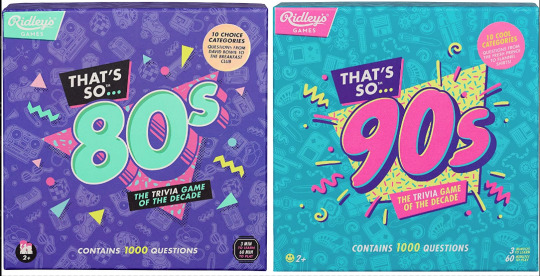
Couple years ago I saw these two board games at the store back to back. Well, not saw them per se, but ya know. Spied them out of the corner of my eye. And for a moment without reading the text, I couldn’t tell you which was which decade at first. Funny. Either they were in a rush to get these out the door or they wanted their throwback trivia game boxes to look uniform. I didn’t think too much of it.
Only, from then on I started seeing it MORE. Every time someone markets a 90s or 80s throwback...
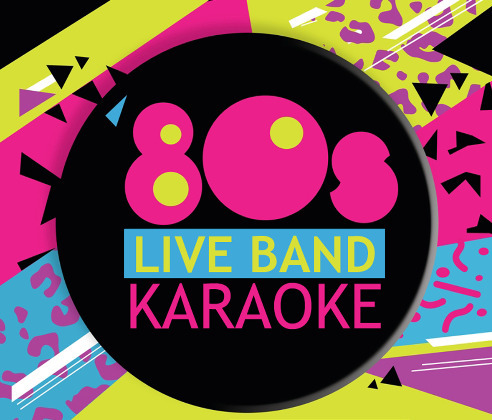
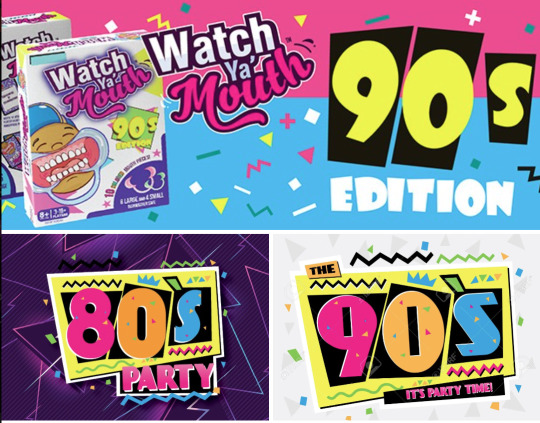
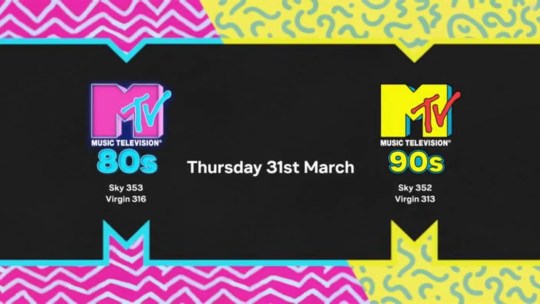


Goddammit they’re identical! What??! How did we let this happen? As a 90s survivor and a designer, this drives me up a wall.
Look, I know I’m late to the party to complain about “the 90s look” when we’re just starting to get sick of the Y2K nostalgia train. But c’mon, the 90s were not The 80s: Part Two™
Trust me when I say that we weren’t all wearing neon trapezoids up until the year 2000. The 90s look being peddled is so specific to the tail end of the 80s and an early early part of the 90s - a part of the 90s when it wouldn’t stop being the 80s. This is Memphis design being conflated with the wrong decade.
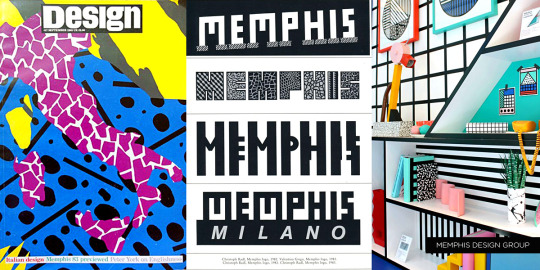

Keep reading for a long ass graphic design history lesson and pictures of old soda and fast food.
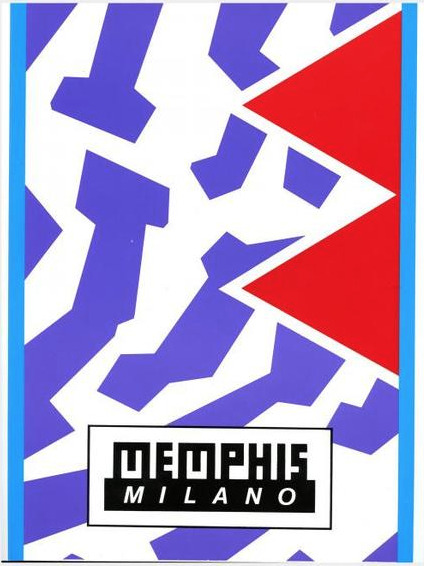
Specifically, the look is Memphis Milano, self-named by the Italian design house Memphis Group. Starting in the early to mid 80s, they made all sorts of furniture, fabrics and sculptures that were like a Piet Mondrian grid painting under heavy radiation. Their whole deal was defying the standards of existing industrial design up to that point on purpose. Chairs had weird arches, bookcases would be in strange alien colors, unusual materials like plastic or elastic were used in place of metal or wood, that sorta thing.

Memphis quickly became the signature look for the decade. You can tell something’s influenced by Memphis design from it’s telltale trademarks:
Clashing, neon colors.
Use of diametric shapes.
Contrasting patterns like zebra print stripes, confetti squiggles and checkerboards.
It wasn’t long before Memphis Milano-inspired design was everywhere in 80s pop culture:


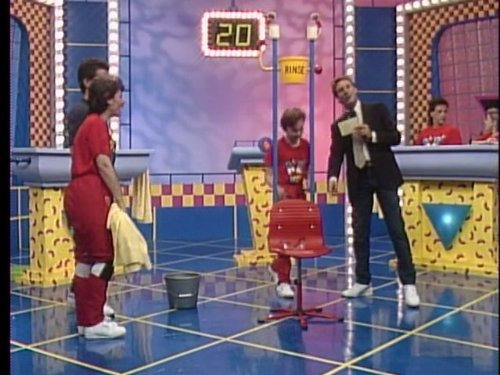




It was a special time, yes.
I was a kindergartener at the tail end of the 80s, so I knew Memphis mostly through the lens of kids media. Toys, clothes, games, tv shows used it like candy colored catnip. Cable channel Nickelodeon more or less adopted the Memphis aesthetic as their signature in-house style and practically built a monument to it at a Florida theme park:
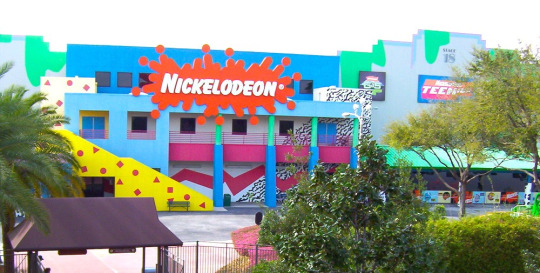
I think this is why folks mistake what decade Memphis is representative of - 90s staples like Nick, Saved By The Bell, Fresh Prince - they all stayed around much longer than the design trend’s expiration date.



Couple that notion with the fact that companies are slow followers to design trends. Something gets popular and they want to get on the bandwagon? Gotta wait for the ink to dry, gotta wait for the production molds to be made. It would take a few years for them to completely work Memphis outta their system.

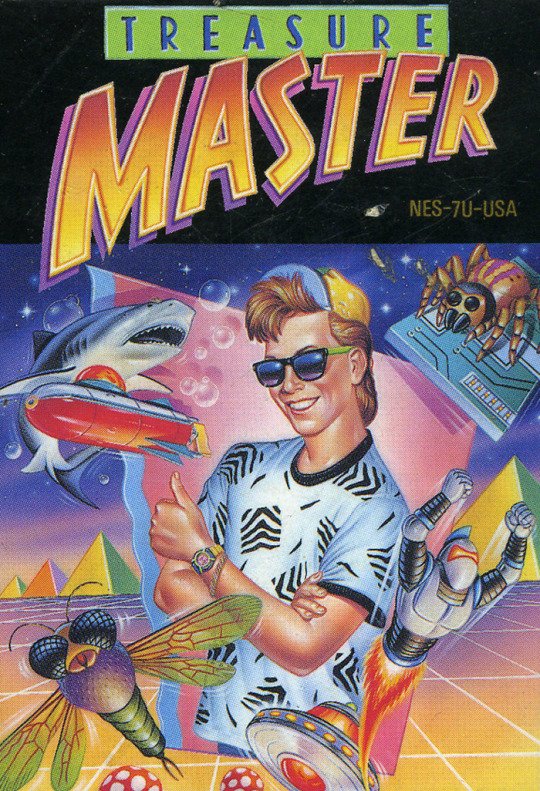

Now, this is not to say Memphis is bad! Personally I’m a fan of the aesthetic, if my neon-drenched artwork wasn’t a tip-off already. But it is a trend, and trends never last forever.
So what took the Memphis Milano look down for good? This part’s up for debate, but I personally think it had something to do with this dude:
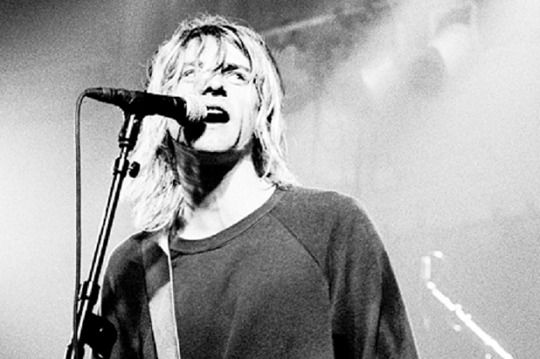
It’s that grunge music from Seattle that’s so popular with the kids these days dontchaknow.
Once Smells Like Teen Spirit hit in 1991, the Nirvana tone drove the rest of the decade. Clean geometry became weathered, grainy and organic. Bright neon pastels became more bold. Bubblegum pop music sounded fake and manufactured. Attitude and apathy was authentic. Whatever.
Things got grungy. Things got grimy. Olestra was invented.
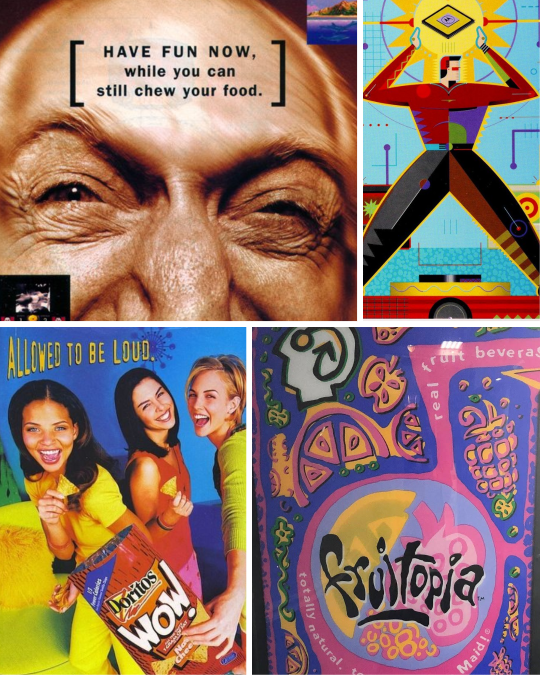
I think the best way to visualize this transition is how Cherry Coke entered the decade and how it left it:
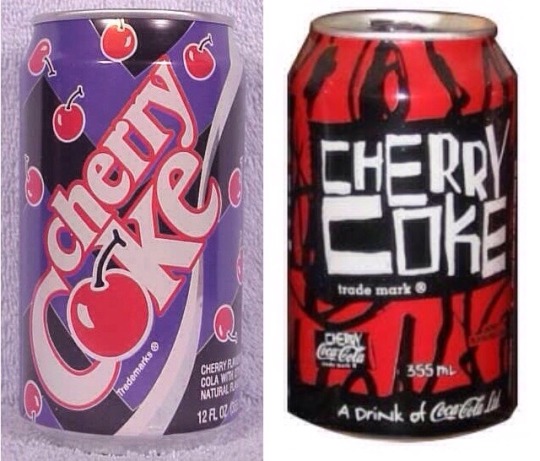
1992 Memphis on the left, 1998 grunge junkie on the right. Fitting that the 90s would end with a design that looked like Darth Maul’s lungs.
Okay, so what should 90s retro design look like?
Continue on to PART TWO! Spoilers: No VHS filters or vaporwave needed, but maybe bring an antacid.
15K notes
·
View notes
Text
i think the reason so many people who were born in the early 2000s feel like "90s kids" is because if you were lower class in the 2000s in a technological and cultural sense it was still the 90s, so much of 2005-2008 "nostalgia" is centred around technology that was wildly expensive, where as most other things from that time did not change between the late 90s to mid 2000s
14K notes
·
View notes
Note
What has served as inspiration for your art style? I’m still trying to improve mine
So much.
Mid-1900s animated American films, from Disney to Don Bluth to UPA. Late-90s to early-2000s anime, especially OVAs (favorite studios were Madhouse and Gainax). Pre-digital comics: The Adventures of Tintin, Pogo Possum, Calvin & Hobbes, Peanuts, Little Nemo in Slumberland. Graphic novels: Hellboy, Blacksad, Jamie Hewlett's work. For individual artists online: my partner Tulliok, Snoozincopter, Alariko, Louie Zong, DeusExMakena, SachinTeng, SsSantine, brawlersworld, Tanjeronie, Carly Henson. There are more but those are the ones who come to mind.
This is an extremely random and eclectic list, but they've all influence the whole body of my work and style, from character design to film composition to storytelling to coloring to line weight. They all reflect something in art that I love: I love flat colors, I love heavy line weight, I love harsh shadows, I love drawing people, I love sci-fi and soft fantasy, I love romance and drama, I love the grittiness of pre-digital art-making, I love the cleanliness and clarity of digital art-making. Check out these works and artists, but they may not embody who you are. The best advice I can give is find and eat and savor as much art as you can and let it change you. Ask yourself why something speaks to you; it can be as small as the way someone draws an ear. Ask yourself why that artist decided to draw it that way. Then make it your own.
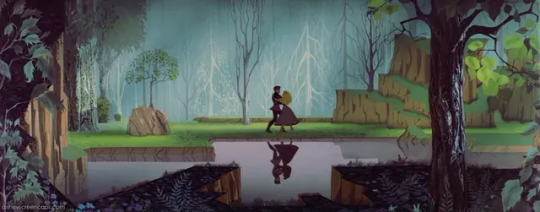
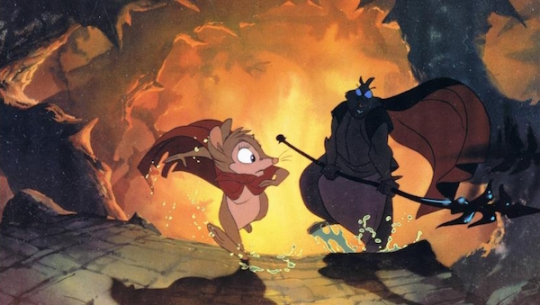



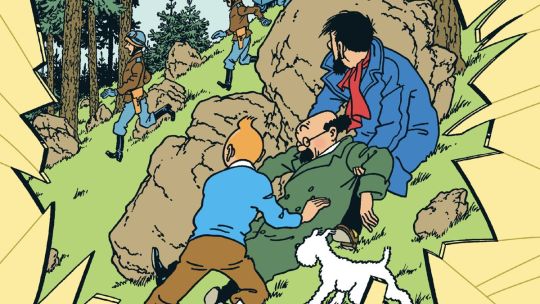
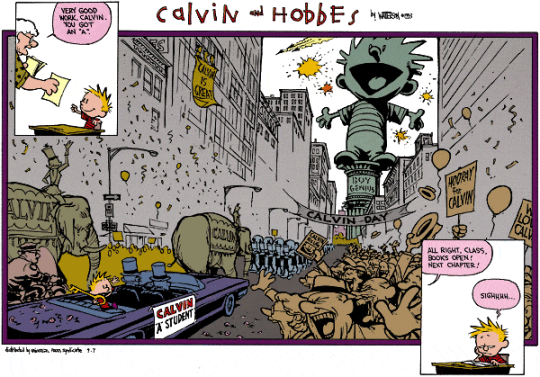
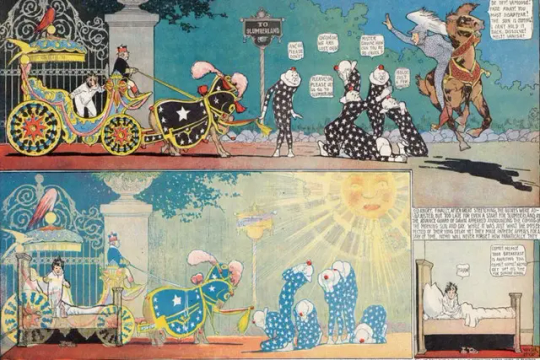

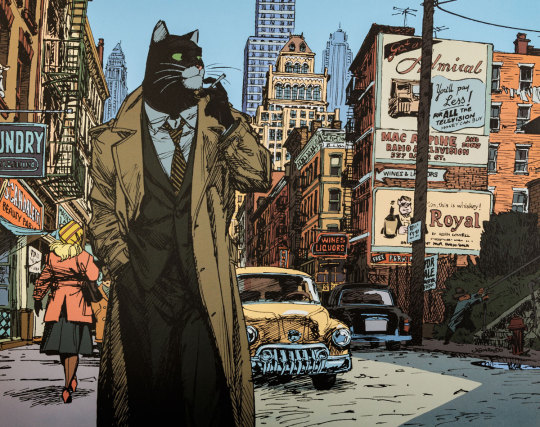
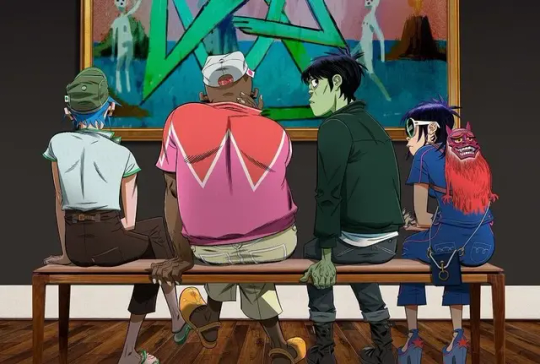






Your inspirations should be as multi-faceted as you. Have fun!
#ask me#fionacle#long post#bottom row of artists are tulliok; snoozincopter; alariko#louie zong; brawlersworld; carly henson#this is only art inspos. i'm also very inspired by live action films and music and books and video essays and whatever#but that's a lot
248 notes
·
View notes
Text
You know, Carrie probably stuck around in the public consciousness in a much more active way on Earth Bet than it did in our own universe.
Think about it: Carrie - the novel - was published in 1974, and it was in 1987 when the active parahumans at the time decided to go public. We can assume that, because they could decide to go public in the first place, there were probably not that many parahumans around at the time, but even so, there had to be some people with powers by that point. So that's our baseline: 1987 is when people had powers.
1974 to 1987 is a little over a decade, which is a while, don't get me wrong, but it also isn't really enough time for something as widely popular as Carrie to fully leave public consciousness, like how there are plenty of books from the mid-2000s and early-2010s that sold well enough to stick around as something people are aware of and talk about in 2023.
Seeing as how the emergence of powers seemed to ramp up after 1987 in the Worm universe, it likely was not that long (late-80s, early-90s) until you had a mass casualty event which echoed the events that transpired in Carrie. Some kid in highschool going postal with powers nobody thought were possible and had no reason to expect.
I mean, shit, technically the Slaughterhouse 9 was around in 1987.
And people would want to look for some way to contextualize that, to understand horrible tragedy like that, or just find a reference frame for it, and waiting for them, as if by design, would be Carrie, which was likely not even fully out of the public consciousness by this point. A story that has paranormal elements that aren't quite mystical, where the powers are fantastical but the situation itself is almost mundane in its cruelty and ends in a lot of dead teenagers.
I can only imagine Carrie reasserted itself in mainstream culture at that point.
I never really dwelled on Taylor making a reference to Carrie back in the story. I could put two-and-two together. But I imagine her thinking that probably carries a whole lot more weight in her world, where that shit can and almost certainly has happened, then it would here, where Carrie is mainly known for being a good novel that kickstarted Stephen King's career, and where "going Carrie" is an evocative phrase, but nothing more than that.
It also makes me wonder what kind of existential crisis Stephen King would have gone through in Earth Bet. Imagine being The Guy Who Predicted The Horrors.
#worm#parahumans#analysis#i guess?#carrie#also i guess?#im not sure if my thoughts here got across well#sometimes i just like to sit and think about all the weird culture stuff going on in earth bet
308 notes
·
View notes
Text
when robots got muscles
You can blame @centrally-unplanned for this post. She(?) wrote...
The ‘chrome’ designs pioneered by illustrators like Hajime Sorayama (Sexy Robot from 1984, for example) tended to be more in vogue at this time (or just…a hot girl, who is apparently a robot, trust me bro), you don’t see designs like this too commonly until later (ask resident robo-fetishist/animator expert @canmom for details on that timeline).
After a challenge like that how can I refuse? Although the question is ‘when did robots get muscles’, this turned into something of a historical survey of robot designs from the 80s on with a throughline of biomimesis.
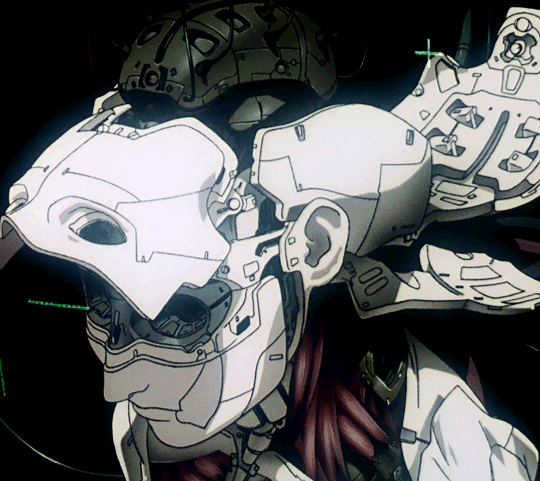
(Originally this was just going to be an excuse to talk about Ghost in the Shell... but I gotta be thorough.)
This was all brought on from this picture from a 1989 fanart magazine...
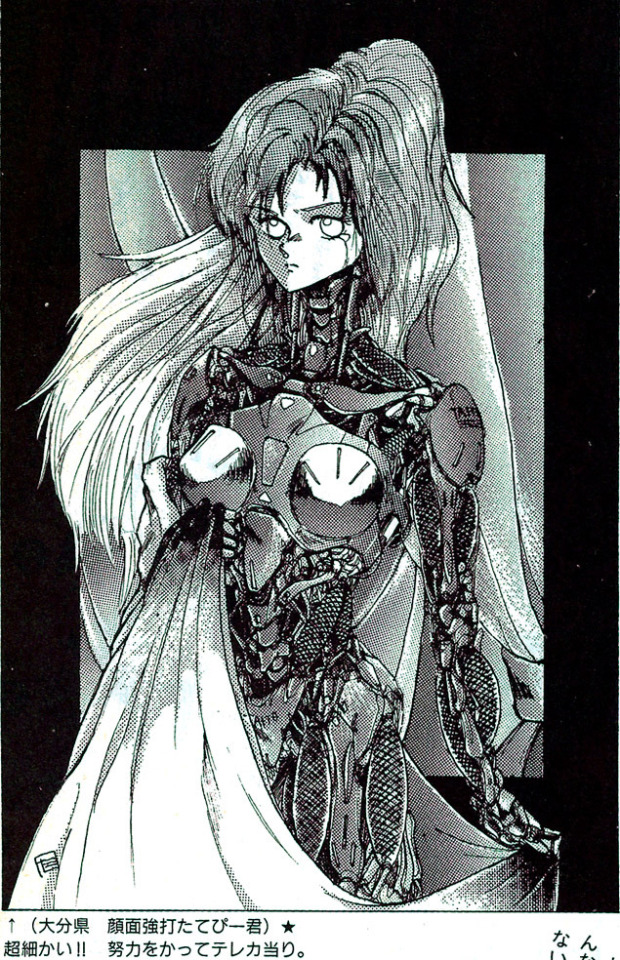
by an artist going by ‘Facepunch Tatebi-kun’ (顔面強打たてびー君, Ganmenkyouda Tatebii-kun). I remarked that it was interesting to see these kinds of ‘robot muscles’ in a picture from 1989, since I thought that kind of design became popular in the 2000s.
On some reflection, I think I gotta revise that opinion! I think ‘robot muscles’ became a thing around the mid 90s in anime; in the West I think it took a bit longer. But you can also see precursors already before that.
So. One thing artists are super into is biomimetic robots. That is, robots whose form (and perhaps function) is similar to animals, especially humans. The word ‘android’ referring to a human-like automaton dates all the way back to the late 19th century, but the modern ‘android, robot, cyborg’ taxonomy apparently became established around the 40s.
There’s two types of humanoid robot that get a lot of play, especially in anime. One is the convincingly humanlike cyborg, which is the same size and shape as a normal human; the other is a what we call in English a ‘mech’, i.e. a big robot you can sit inside.
Of course, if your androids just act like humans all the time, then there’s not much point having them be robots. To really create the frisson of contrast between human and mechanical forms you have to show the mechanism somehow. This could be because the machine isn’t perfectly human-like, and has visibly mechanical joints - take a look at the works of @sukabu89 for very inventive depiction of this theme - or, the android could be damaged or undergo maintenance.
When you attempt to translate biological forms into a more mechanical design language, the traditional way has been to use hard, rigid shapes, since these make the contrast especially clear. In more recent designs, particularly as we started to see real robots with ‘artificial muscles’ such as the ones created by Boston Dynamics, we get another sort of design language to express ‘mechanical parts’, and robots start having more biological forms with exposed plasticy muscles.
So let’s tell the story. We begin at the end of the 70s.
the dawn of mechaguro
For an early example of ‘mechaguro’ (a term I’m applying very anachronistically!), when a robot gets smashed up, we have Alien (1979). This film did a ridiculous amount to define sci-fi design language, and of course the alien itself blends mechanical and biological forms, with its glossy black surface allowing it to seem to melt into the exposed pipes of the spaceship. But let’s focus on the character Ash, a secret android who is broken apart in the second half of the film.

When Ash is torn apart by the alien, his insides consist of weird white plastic beads and a milky fluid that seems analogous to blood. It’s not clear what the function of any of this tech is - it’s intended to be vague and mysterious. The outside is biomimetic but the inside is anything but. He has a kind of artificial skin which resembles a latex mask.
The Terminator films are another major touchpoint for 80s science fiction. Late in the film, Arnie starts taking damage which reveals the Terminator skeleton underneath his fake skin.


The stop-motion Terminator model is basically designed according to the principle of ‘replace human bones and muscles with hard metal bits’. So you have a metal skull, metal clavicles (which are pistons for some reason), metal shoulder blades, hydraulic pistons generally in the places where muscles are. e.g. in the above picture you can see pistons that stand in place of the sternocleidomastoid muscle, and in this picture...

...you can see metal scapulae and piston biceps and triceps and a piston. The shoulder joint by contrast built in a very non-human-like way. Also there’s random tubes everywhere lol.
That’s generally how androids are portrayed in the 80s. The ‘droids’ in Star Wars are similar; C-3PO is an arrangement of metal plates with gaps suggestive of underlying mechanical details and rudimentary joints and pistons.
In Blade Runner, we have the Replicants, humanoid robots - but by the premise of the film, they are essentially indistinguishable from humans. So when the Replicants die, we never really get to see their robo-innards.
and now, anime
OK, that’s the big four Western 80s sci-fi movie series; what of anime? Of course, androids in anime go all the way back to Astro Boy. But most of these early designs don’t really focus on mechanical details all that much. Super robot designs are more like tokusatsu suits than anything. There were certainly instances of impressive mechanical animation in the 70s, with early experts including Kazuhide Tomonaga on Space Battleship Yamato. Then there’s Hayao Miyazaki’s episodes of Lupin III Part 2 which featured proto-Nausicaa flying a prototype of the robots from Castle in the Sky. It would be some years before anyone could come close to matching these!
The original Gundam in ‘79 famously started the ‘real robot’ movement [Animation Night, so let’s take a brief look at how a Gundam fits together.
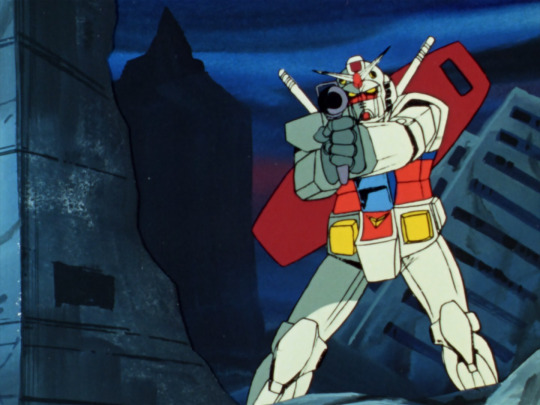
Generally speaking, the way Gundams are drawn in Gundam ‘79 is kind of rough. The methods to animate these rigid mechanical systems in super accurate perspective were just not yet established at the end of the 70s, certainly not on a TV budget. The actual joints on the Gundam are left very vague, but it broadly speaking seems to move like a human in armour.
But the OVA boom was about to begin, and while it would be a while before we saw the heights of Headgear/Production I.G./Gainax, things were going to change a lot. Mechanical design and animation was about to get much more sophisticated very very quickly.
In 1982, we have Super Dimension Fortress Macross, with robots that transformed into fighter jets. Its robots are designed by Kazutaka Miyatake, who cut his teeth doing mechanical design for Space Battleship Yamato and Daicon. The Macross TV series introduced the world to the animation of Ichirō ‘Missile Circus’ Itano. [AN64] A plane with legs... honestly looks kind of goofy, but Itano’s ambition to have a highly mobile 3D camera that could move in ways that would simply be impossible in live action marked a huge step up in how robots are animated. And this would get refined even further in the film Do You Remember Love.
In terms of design, we’re really moving our inspiration from ‘tokusatsu suit’ to ‘military hardware’ here. A Macross suit has to look like something that could transform into a plane, so its silly little arms and legs have to look kind of plane-like. In any case, we are definitely still in a world of hard and rigid robotics.
Dallos (1983-4) dir. Mamoru Oshii is known as the first OVA, if not the first successful OVA [AN115]. It features a variety of mining robots on the surface of the Moon, which are generally less humanoid, taking their design cues from JCBs...

...as well as humanoid robots with fairly clear joint patterns...

...and more humanoid robots too.
The eponymous Dallos, however, is a huge humanoid robot that looks like this...

Here we have a pile of mechanical shapes that vaguely calls to mind a human face. It’s suggestive of motifs we’d see later in works like Akira.
A year later in 1985, Megazone 23 really kicks off the OVA boom in earnest [AN 103]. It also has a robot, in the form of a transforming bike that can become a humanoid piloted mech...
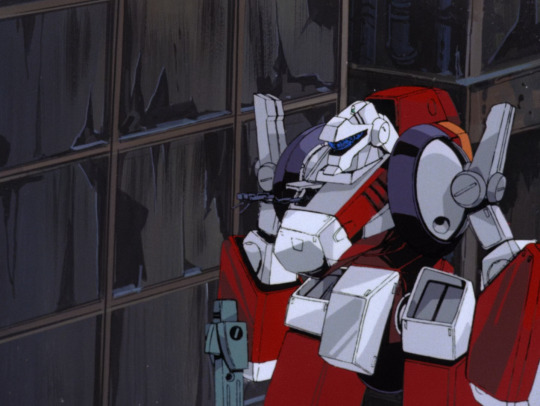
You can see mechanical designs and shading have become considerably more detailed; its motion is a lot more complex as well with a ton of indulgent background animation shots. The actual details of the bike -> robot transformation are rather brushed over. But to sort of sum up the design language: we have organic but hard-edged shapes contrasted by inorganic but round shapes. (These terms ‘organic’ and ‘inorganic’ refer mostly to symmetry and a sense of ‘flow’ in the shape.) There are few right angles as such, but a lot of broadly boxy topology. The shapes are broken up by elaborate specular highlights in complex shapes, a motif of the later Kanada school.
OK, but that’s all variants on ‘rigid robot’ so far - what about the androids? What about the more directly biological designs?
Following the enormous success of Megazone 23 Part I, Toshiki Hirano got the chance to adapt his favourite lesbian cosmic horror hentai manga Fight! Iczer One into a rather more tame OVA which released from 1985-87. In terms of mechanical design, this starts to do some interesting moves towards blending biological and mechanical forms...
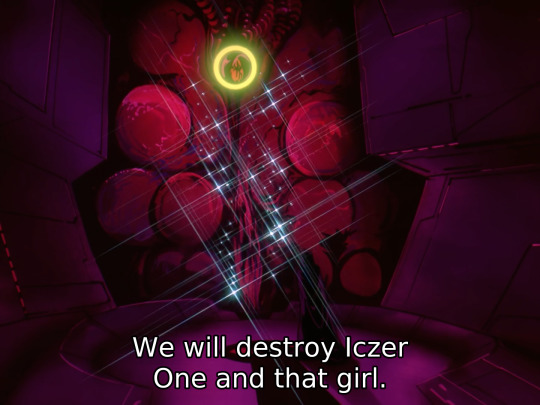
Of course it has a robot in addition to the requisite bishōjo and lightsabers. In contrast to the boxy shapes we’ve seen so far, the robots in Iczer-One have a much more curvy organic sort of design language. Still, there is not a lot of emphasis on the precise details of mechanical articulation outside of select shots. (It is however notable for the first ever Obari punch!)
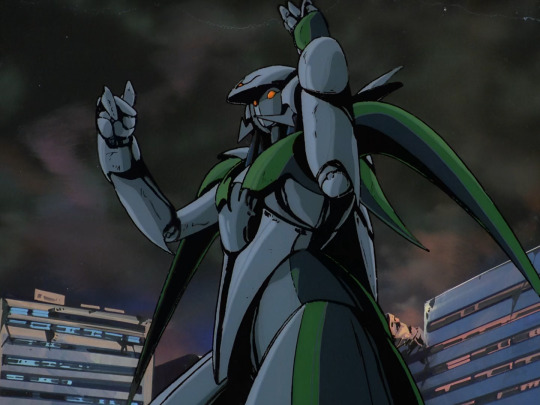
Despite the change in shape language, these are still very clearly animated as metal plates and not yet muscles.
In 1984 we have a very important film (for this narrative, and in general), Nausicaa of the Valley of the Wind, the film that created Studio Ghibli. Here we have the ‘God Warriors’, giant humanoid weapons with the ability to shoot a massive laser out of their mouth. Rather than robots, these are very much biological in nature, having to be grown in a kind of cocoon. In the film version of Nausicaa, an incomplete God Warrior is released, leading to an iconic scene animated by Hideaki Anno in which the God Warrior attempts to blow up the oncoming wave of Ohmu.

The God Warrior’s melting flesh is gorgeously animated, bubbling and sloughing off in great big lumps as the skeleton pokes out from underneath. Throughout, Nausicaa is full of beautiful and impressive animation of both machines (mainly planes) and biological (the giant insects), but the God Warriors, as human-made lifeforms, bring the two together. However, this strand wouldn’t be especially followed up on for a long long time.
Right, but what about Bubblebum Crisis (1987-91)? That is, after all, the iconic 80s robot girl OVA. It’s inspired heavily by Western robot-related films like Terminator and Blade Runner; here we have ‘Boomers’ (never stops being funny) as androids that can appear convincingly human. Like the Terminator, the underlying metal parts can burst out. Here we have a metal frame designed to resemble muscles, and also metal tentacles.
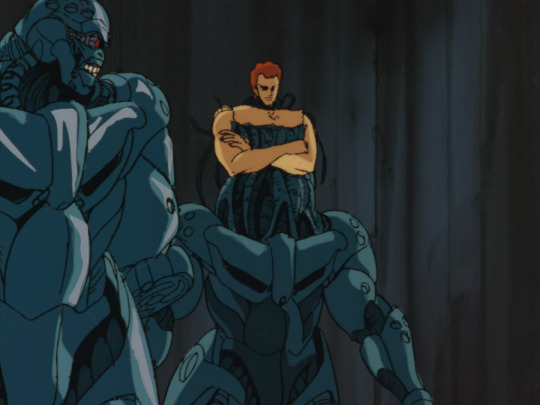
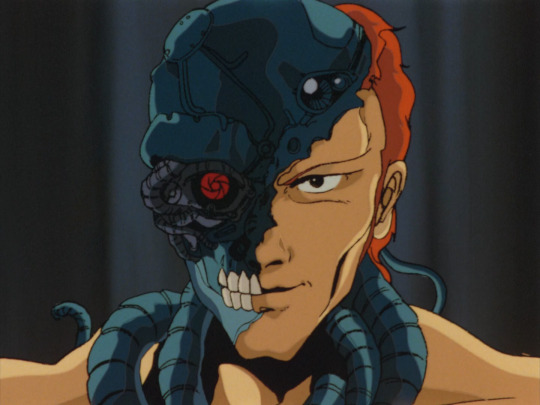
The shapes of these robots are a lot more organic. The robot neck has tubes that sort of resemble the neck muscles, metal plates that resemble pectorals and abs and deltoids and biceps and so on. You’ve even got a direct riff on the Terminator ‘fleshy face falling away to reveal metal skull with glowing red eye’! Under the plates there are clusters of tubes which also heavily resemble muscles. Also you’ve got the classic ‘three small circles’ motif there.
Contrasted against them are the Knight Sabers, who aren’t cyborgs as such but fight in powered exoskeletons which fit the design motifs of robot girls.
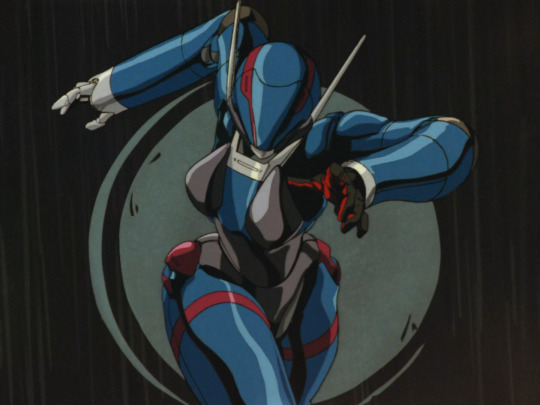
These suits are quite form-fitting, with a rubber under-layer and metal shells on top. There is definitely some attention paid to how they’ll articulate around the joints. One very recognisable 80s motif is the sort of extending spike thingies you can see on her hat there; there’s also the jets that extend out behind the suit. And, you have that multi-layer shiny highlighting of course!
Still, the way the characters move in Bubblegum Crisis is still very squarely Kanada School poses; big movements, lots of held poses accentuated by flashing and line boil, not a lot of concern for conservation of momentum or anything like that.
For a contrasting strand we can look at the rise of the ‘Otomo school’ (if you will) of realism. Around the end of the 80s, a pool of talented animators were gathering around Katsuhiro Otomo. Their most famous work is Akira, but I’m actually going to begin with Robot Carnival (1987), a wonderful anthology of short films from 1987. This features a huge variety of interpretations of the concept of robots.
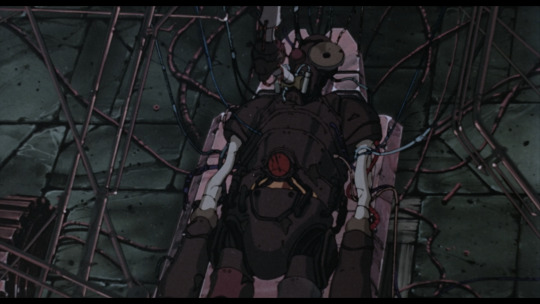
For example, for Kōji Morimoto, later co-founder of Studio 4°C, the robot is a kind of cobbled-together steampunk Frankenstein’s monster. It’s a very cool design with all sorts of asymmetries and exposed parts suggesting its cobbled-together nature. And although all the robot does in this short is stand up and then fall over, a great deal of attention is paid to the little details of its articulation and its movement through space.
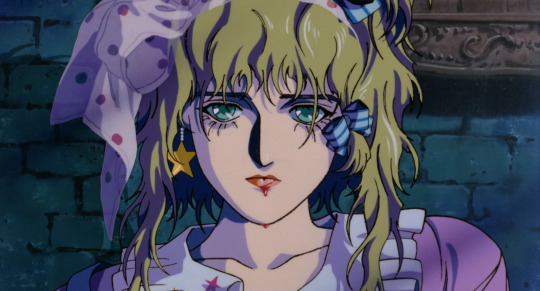
Presence, directed by Yasuomi Umetsu, is notable for its steps in the direction of realism - Umetsu’s characters are hyperdetailed and in some ways over-drawn. The opening shots establish this is a world where lifelike androids are common, when an android gets his head kicked off and stolen by children. Here the robot-as-doll metaphor comes in, something that will be increasingly central in the next decade. The robot girl is essentially a human-sized doll in a room full of other toys. Her creator smashes her to pieces with a wrench; later her ghost visits him as an old man. We see the girl attached to a bunch of wires, but she bleeds like a human.

Cloud by Manabu Ōhashi features another humanoid robot, an Astro Boy-like child recognisable as a robot based on his segmented torso and legs and robotic ear... cones. Here the robot is a standin for human emotions, the boy’s struggles projected onto the constantly changing sky as he walks against the wind.
Strange Tales of Meiji Machine Culture: Westerner’s Invasion by Hiroyuki Kitakubo (later to direct Golden Boy, Roujin Z and Blood: The Last Vampire) is a sendup of mecha shows in which two very goofy looking steampunk robots operated respectively by Japanese and Western crews duke it out, laying waste to the city around them. The Japanese robot is basically a big wooden samurai...
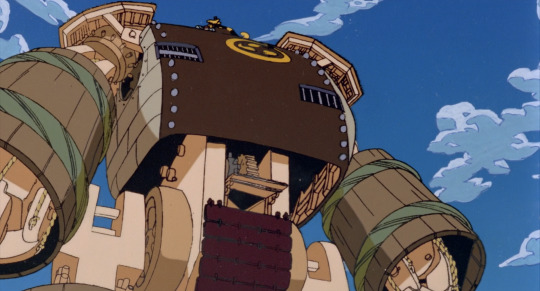
and the Western (more specifically American) robot is, uh
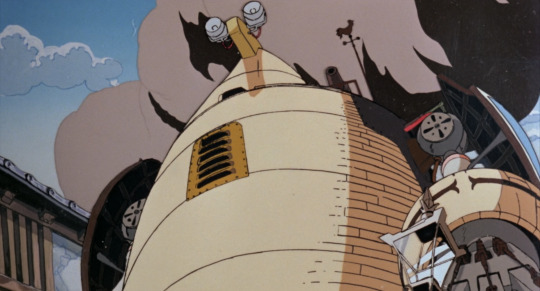
sorta big barrel with little eyes on top? I’m not entirely sure what the deal is with this design!
That’s really not relevant to our story tbh I just think it’s a neat short.
Chicken Man and Red Neck, by Takashi Nakamura, features especially distinctive robot designs. The film is kind of a dream sequence in which a terrified drunk man witnesses the revels of the machines of Tokyo, transformed into robots; the robots are extremely shaped, moving through a world that is pretty much just pistons...
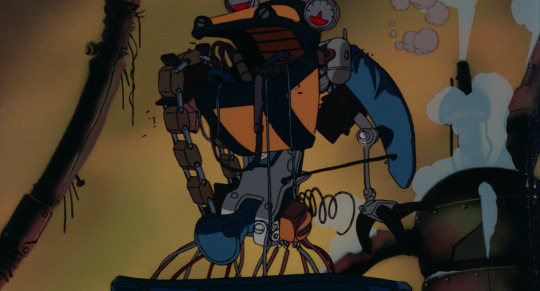
These robots call to mind the dancing demons in Fantasia’s Night On Bald Mountain sequence, or even Bosch.

Otomo’s own segments feature the Robot Carnival itself, a vast mechanical structure built as... well some kind of entertaining spectacle, but which now drives around the post-apocalyptic wasteland dropping robots which explode as bombs. It’s cute.
OK, to wrap up the 80s, we gotta cover Akira (1988) [AN34]! Akira has plenty of impressive mechanical animation of helicopters, hovercraft thingies, satellite lasers and of course the famous bike, but it doesn’t really feature robots as such - but what it does have is a blending of mechanical and biological forms in its climactic sequence where Tetsuo’s psychic powers go out of control. First, wires start to spread like the roots of a plant from his robot arm - less an actual machine and more something he assembled with his psychic powers...
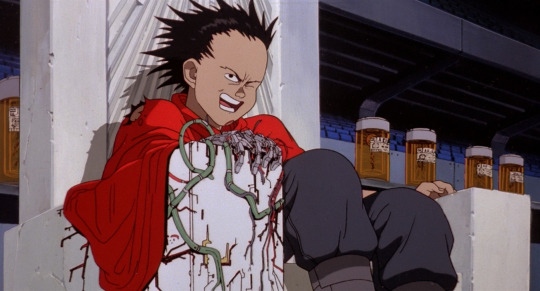
He takes a bullet, and the mechanical wires and muscles start to blend together and spread out like a slime mold...

...which he can extend as essentially a giant tentacle.
When his powers fully go off the rails, he bulges out into big blobs of flesh which have both veins and wires running over them. These burst out of the metallic parts as well.
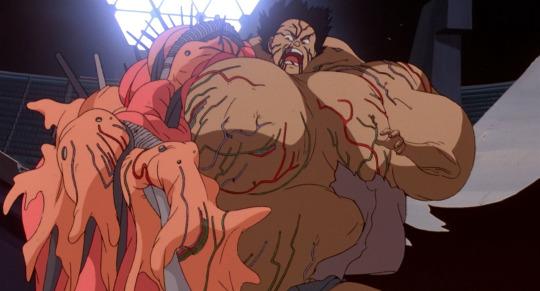
He turns into essentially a giant biomechanical baby.
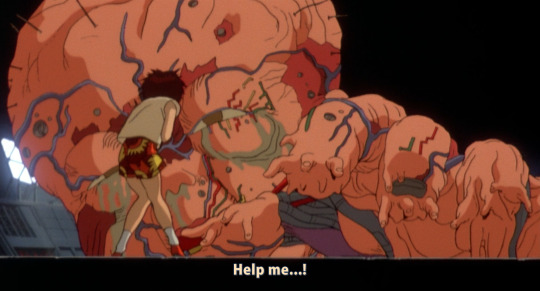
Did Akira invent these images of blending biology and machinery? Probably not, but I’m not really familiar enough with manga of the time to say. What can at least be said is that Otomo’s absurdly meticulous style could really sell it. Otomo was truly a god of perspective and detail; Akira the film was an enormous, prestigious production that threw ludicrous effort and resources towards realising his vision (which doesn’t mean it paid its inbetweeners much more...). A lot of the animators who worked on Akira would go on to be prominent in...
the 1990s
So, the 1990s. If the 80s was dominated by the later Kanada School, the new movement of the 90s, at least as far as film animation goes, was ‘realism’.
But before we get onto that, let’s take a brief look at Gunnm (1990). Known as Battle Angel Alita in the West, this manga by Yukito Kishiro depicts a world in which most people are cyborgs; it was adapted to an OVA by Madhouse in 1993 and became wildly popular overseas. Its protagonist Gally, aka Alita, starts out the story as a wrecked cyborg body like this...
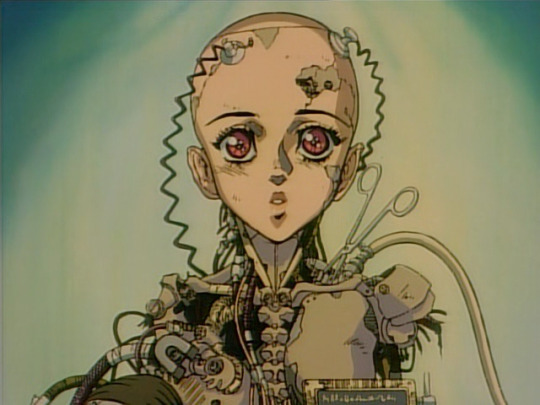
Looking at this design, you can see similar patterns as we have so far. We have metal clavicles, metal sternocleidomastoid muscle, metal pectorals, metal spine. There aren’t robot muscles, per se, but there’s a lot of attention to detail on mimicking biological shapes.
Before long she is rebuilt (twice in the manga, once in the anime). Her new body is like this...

...which is to say a skintight bodysuit in the middle, and metal arms. These arms, although designed in a way that indicates hard surface and with a hinge joint at the elbow, are designed in a way that mimics the flow of muscles in a human arm. By contrast, her sorta-love interest Yugo has a body like this:

which gets mashed to pieces in the finale of the OVA. There’s a striking mechaguro scene in which Gally catches Yugo, but leaves him hanging by a fraying arm, which snaps, leaving him to fall to his death. Compared to later iterations of the ‘robot arm torn apart’ device, this one’s relatively light on detail...
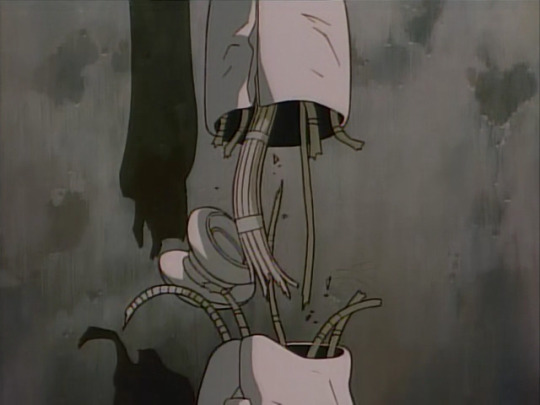
Cyborg bodies in Gunnm are used as a visual indication of character type. Gally has curves but also sleek robo muscles: she’s a Beautiful Fighting Girl, sweet but also extremely powerful. A huge ‘muscular’ cyborg with wide shoulders is likely to be a brute. Yugo here has much more plain, simple shapes with visible bolts, not precision pieces like Gally.
I don’t know how much of this originates with Gunnm. I’m sure the idea of cyborg girls was in the air long before, but this became an influential example on the tail end of the time of the 80s bishōjo. One device that is notable here is the idea of a ‘full body cyborg’, which is only human down to the brain (or perhaps not even that). Body swapping is a major theme in Gunnm, something that would be expanded on before long...
And if that was going out, what was coming in? Let’s look at Patlabor, which traces the evolution of the Headgear artistic collective and IG Tatsunoko into Production I.G.. This is about as down to earth as giant robot stories can get, with robots as just everyday machines used for work and by the cops. But where things really go nuts in animation terms is the opening to Patlabor 2 (1993).
youtube
Here you can see some of the most impressive sequences of mechanical animation ever drawn. We see pilot Noa testing out the robot, and especially notable are the scenes of the hand flexing and of walking. Enormous attention is paid to the articulation of joints. The robot’s hand can swivel 360 degrees, unlike a human; however, like a human, the articulation of the fingers seems to be controlled by hydraulics in the forearm (whereas in humans, the muscles and tendons in the forearm control our fingers). When the robot’s foot steps, it flexes like a real human foot, with believable joints, and a sensible arrangement of pistons to absorb force.
It’s not imitating a human’s muscles, but the attention to the details of the robot’s mechanical design serves precisely to draw our attention to the ways it’s like/unlike a human - the robot’s hand impossible motion immediately contrasted with its pilot shot from the same angle. And the perspective drawing is absolutely impeccable. The robot is made of purely rigid structures, and the way rigid structures articulate is not at all how a human’s joints articulate.
The sequence above was animated by Atsushi Takeuchi. But across the board, the bar was getting pushed for mechanical animation. For example, observe this cut from Mobile Suit Gundam: The 08th MS Team (1996-1999), in which the robot tears off its own arm and beats up another robot. The precision of the way the joints are animated and the way the robots move in space is just completely on another level compared to what Gundam had been doing a couple of decades prior.
Anyway, we’re here to talk about robot muscles, and we’re just a few years out from that now!
The year that robots got muscles, at least as far as anime is concerned, is 1995.
You can probably guess the next part. In 1995, we get Eva and GitS. Let’s start with GitS, to continue the Production I.G./Mamoru Oshii thread. The opening sequence of GitS, animated by - who else could it be? - Hiroyuki Okiura - has to be one of the most iconic segments of video ever drawn. Here’s a merely 720p youtube upload but go and find the place you have GitS stored on your hard drive and watch it in proper quality eh.
youtube
OK, yes, a lot of it is a naked lady floating around, sue me or whatever. But the sense of form. We see early on an appearance of ‘robot muscles’, here closely resembling real muscles...
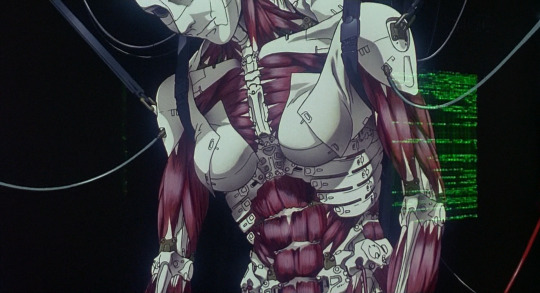
We can see from the way this is drawn that it’s made of a combination of artificial muscles, solid segments, and flexible, fabric-like panels. One of my favourite shots at the beginning shows the solid segments of the skull clicking into place. Here we have a very clear contrast between the angular, hard edges of the mechanical pieces against the organic forms of a human body.
Elsewhere in the film, we see various incredibly cool bits of ‘wouldn’t be fucked up if a body did this‘, like the fingers...
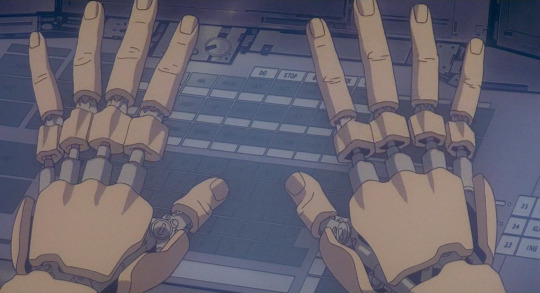
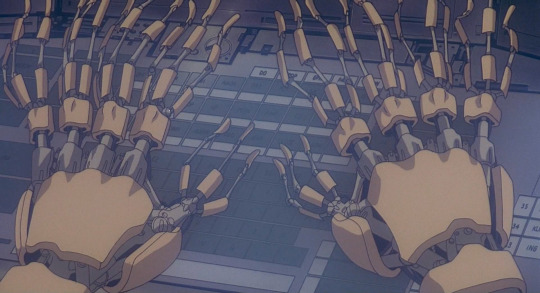
Here, what we expect to be soft biological fingers is contrasted with unexpected rigidity, mechanical joints under a shell.
Also in this scene we encounter a robot body that has been stripped of her arms, legs and hips but is nevertheless still alive...
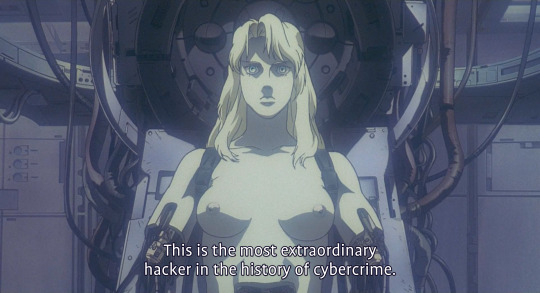

most extraordinary hacker in the history of cybercrime and you have your titties out and yet you still can’t get them to stop misgendering you, smh
For the Terminator, having its body smashed up and continuing to walk was a demonstration of its strength. Here, as would become perhaps an increasing motif, having a robot body is a source of vulnerability: people can do things to you that would kill an ordinary human but you keep going through it. Not surprisingly, ‘robot body maintenance’ is a recurring porn device. (One that GitS deploys in SAC s2).
But of course this all builds up to the all time classics of mechaguro scene at the ending where the Major attempts to tear off the hatch of a spider tank. Muscles ripple individually under the surface of her skin, her arms bulge in exaggerated contraction, and then her arms fully tear apart under the force.
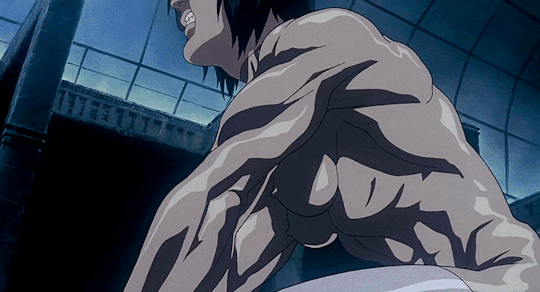
Here, we’re showing her as mechanical not by contrasting rigid forms with biological ones, but by exaggerating the biological ones to the point of doing something extremely unnatural. Human muscles do not generally flex in such an individual way, nor are they strong enough to tear the arm apart, but robot muscles? Yeah, they could do that. This sets up the next scene where the Major lies unnaturally still, but can still exert control through hacking through her union with the Puppet Master.
Robots holding onto something so hard their arms explode has become... if not a recurring image, then at least one that was called back decades later in Violet Evergarden.
The final scene of GitS brings back the image of robot-as-doll, with the Major’s consciousness now uploaded into a black-market robot body that resembles a child in a dress.

This is further expounded on in Oshii’s second GitS movie Innocence (2004), with its Ballade of the Puppets in the soundtrack as Batou and Togusa (and eventually, the Major) are attacked by essentially an army of ball-jointed doll gynoids. The puppets’ movements are extremely unnatural and erratic acrobatics, constantly flipping all over the place; when hit by bullets, panels pop open to reveal the underlying brass skeleton. It’s a very cool image. (The thing that lets the sequence down is the extremely dated CGI and aggressive digital compositing.)
It also has Donna Harraway as a literal cyborg!
Now, the GitS movies didn’t drop fully formed out of nowhere, but draw on the work of Masamune Shirow. The manga has a somewhat different design sensibility than the movie, distinctive and shiny as all Shirow’s art. It is more rounded and organic, less cold.
So, the basic design of a cyberbody originates with Shirow. You can see it on this page (unfortunately from a flipped version, translation Dark Horse):
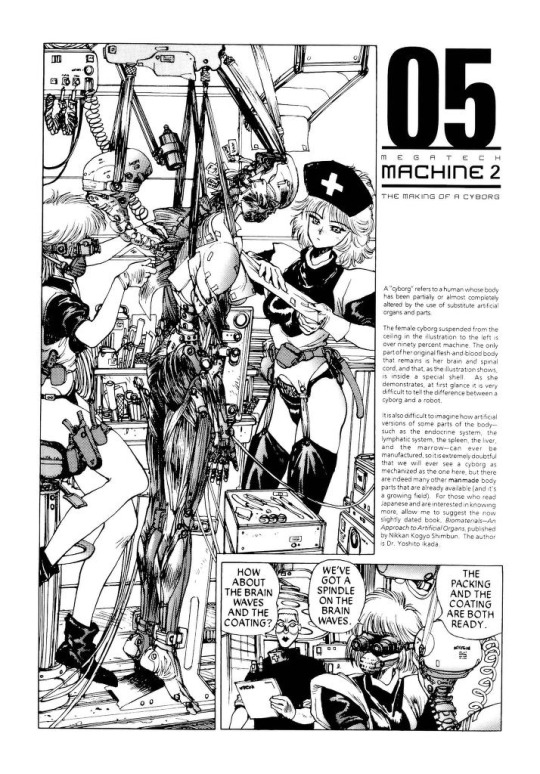
You might be able to determine from how the nurses are dressed that, yeah, the GitS manga is in significant part fetish porn. But really nerdy fetish porn, which is the best kind. This chapter is almost entirely dedicated to explaining how cyborg bodies are constructed in great detail, from the ‘sensory film’ (that’s what’s being applied in the opening to the 1995 film) to the hair implantation.
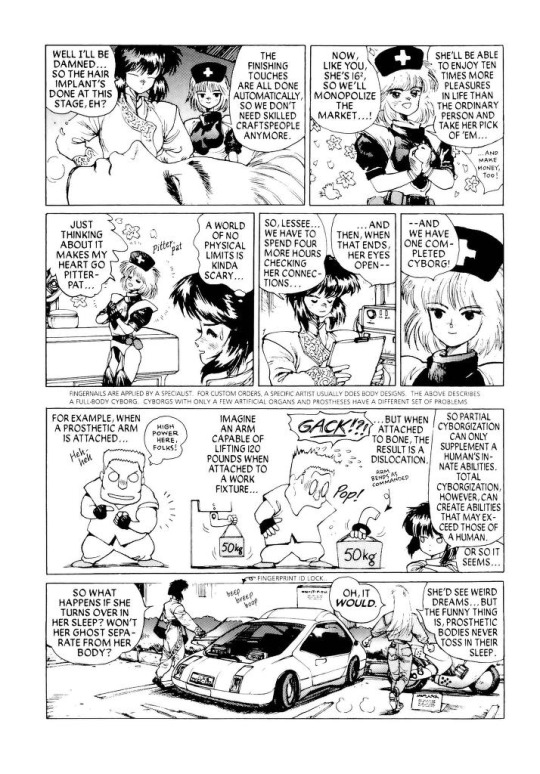
It’s interesting seeing how some of the more out-there designs of the manga, like Chief Aramaki, are transformed into the realist style of Hiroyuki Okiura. It’s Okiura, so it works great of course.
I don’t know if there are manga examples of such detail about cyborg bodies that predate Shirow.
Anyway, that’s just one of the two punches dropped in 1995. The other is Neon Genesis Evangelion. To the pedants: sure, the Evas are not actually robots, but they’re giant cyborgs that play the role of ‘robot’ in the story and they look like robots so I’m counting them.
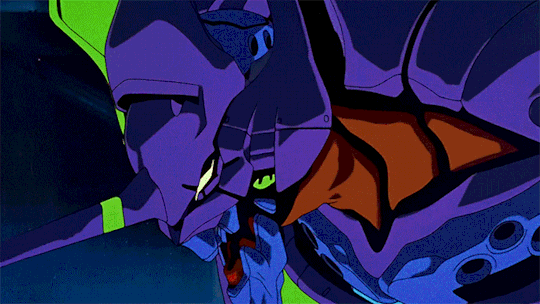
Anyway, the thing about the Evas is they are incredibly lithe. They run, rip and tear and swing heavy objects around in a way that’s both weighty and distinctly biological. Their bodies are extremely flexible compared to prior mechs (look at how much the spines bend in that Iso cut from EoE!), but not without hard, rigid components such as the shoulder towers. Their jaws are bestial but feature mechanical-like components like interlocking hexagonal teeth and jet-like vents. They are in short a fantastic design that blends biological and mechanical features.
The impact of Eva on just about everything can’t be overstated, but as far as robot design, well. There certainly were works that leaned on the precedent set by Eva, as for example RahXephon, which also treats robots as something spiritual, prone to popping into a blob of weird little bubbles just like in Eva.
There’s a great deal missing from this account. I am very focused on anime because I’ve watched a lot more anime than I’ve read manga or played games from this period. So I’m sure there’s major foundational works I’m missing here!
the 2000s
When did the West start to catch up? eh that’s subjective - David Cronenberg was way ahead of the game! - but specifically in the sense of robots with mechanical muscles, I think the major points in the timeline go a bit like this.
In 1999, there’s the Matrix, which leans heavily on anime. This features a similar ‘robot takeover’ premise to Terminator, but here it’s biomimetic robots modelled after squids, with clouds of constantly moving tentacles that sweep behind them. After making a cool half a billion dollars, the Wachowskis decided to pay all their favourite anime directors to make short films. I’m not going to comment on every part of the Animatrix, since most of it isn’t really relevant, but I will point to this horrifying cut by Takeshi Honda in The Second Renaissance in which a robot woman has her clothes torn and then skin bashed off by a mob. The framing, motion, her expression of abject terror, and the ‘reveal’ of her ‘true’ nature, all viscerally call to mind a trans bashing.
On the manga side, a big one to mention is Gantz, a gory nihilistic seinen manga which ran from 2000-2013. The characters in Gantz fight in special latex-like suits which take on the appearance of muscles while engaging superstrength, but can also sustain damage that causes them to drip fluids from ports located at the neck and become fatal to their wearer. Gantz was adapted to anime by Ichirō Itano in 2004, but I haven’t seen it so I can’t comment on any notable animation.
Cyborgs are a favourite subject of games, but in the 2000s, games are really pushing art direction and biopunk stuff is in. Half Life 2 (2004) has its spider-crab like Striders and dropships and so on. Oddworld: Abe’s Oddysee (1997) bases its whole concept around the sheer variety of weird creatures that would inhabit its dystopian factory. And I gotta give a shoutout to Septerra Core (1999) - in case one other person has played that lmao
At some point after 2005, Boston Dynamics became a viral sensation thanks to their robot BigDog. BigDog is just welded steel and hydraulics, but its lifelike hopping movement style definitely brought to mind the idea that the future of robots is going to be in biomimesis.
So, 2007, here comes Crysis to melt your PC! This is an FPS with the not-uncommon premise of being a supersoldier fighting (country America hates) and also aliens, but its gimmick was that you have a special exosuit that wraps around your body with artificial muscles, making you much stronger and manlier or whatever.
youtube
This is indicated by a visualisation that could be right out of a toothpaste ad, where tiny little balls drop into the character’s pores and somehow go straight into the bloodstream which is of course a void full of flying red blood cells. And so on. It sold the game, though! The ad there focuses almost entirely on the suit and not the character wearing it, who is basically an irrelevant soldier man. What it entailed in gameplay terms is that you have a mode switcher so you can have strength or armour or invisibility or whatever. But it’s cool military superscience, you see!
Anyway. Not like my preferred flavour of cyborg is any less stupid I guess x3
In the same year, Bayformers started. These films’ robots are honestly just visual noise, there’s so many moving metal shards going every which way that it’s next to impossible to discern any sort of underlying mechanical principle. A similar ‘overwhelming business’ visual effect would be applied the next year in Iron Man, kicking off the MCU. So mechanical muscles definitely weren’t the only expression of ‘hyper-advanced robot’ in Western visual media in the late 2000s.
I’m going to end my story with two more games: Horizon Zero Dawn and NieR Automata.
Horizon features a world inhabited by a large variety of robot animals, using the peak of AAA rendering techniques. The robots are designed to be biomimetic after both modern animals and prehistoric ones, and feature a combination of hard surfaces and softer biological muscles. For example, a robot horse:
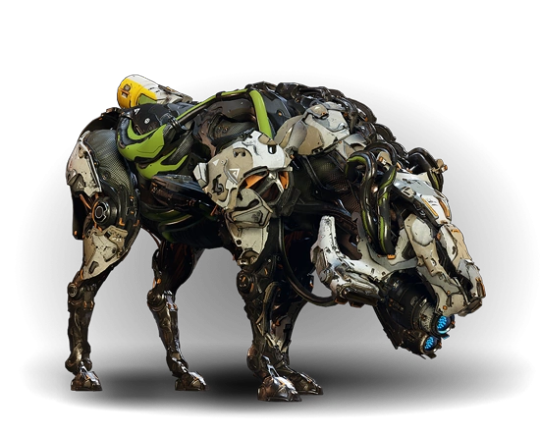
The discipline of making designs like these now has a name: it’s called ‘hard surface modelling’ and it involves boolean operations and bevels and other techniques designed to create a balance of hard edges on a surface against the smoother parts. The design language of Horizon says that the hard plates are white, the soft parts are very dark and may be patterned like a cloth texture, and there can be small colour accents here and there.
I think you can definitely see the influence of Boston Dynamics’s robots (and recent military tech in general) in these designs, iterated on through a decade and a half of increasingly intra-referential concept art. They are visually very busy designs, but there are a couple of recognisable features that draw attention by being inorganic, such as the cylindrical fuel tank at the back. Vitally, the silhouette is very readable.

This robot T. rex for comparison serves as a world boss monster, and you can see it’s got a bunch of military looking attachments that look like radars and missile launchers and so on. As real tech evolved, so too did our idea of what a scary robot ought to look like.
So, that’s where this kind of design pattern has gone in mainstream games.
Now to finish, a brief comment on NieR Automata. Its designs draw hard on those of Ghost in the Shell. Visually it draws a strong contrast between the Machine Lifeforms, who have inorganic shapes (spheres and cylinders) and very visible and plausible mechanical joints, and the doll-like androids, who might as well be human (although A2 provides some contrast in an android who is damaged enough for the underlying materials to show through). The mechanical nature of the androids is communicated by the acrobatic way they move and the interface elements, and dead androids you find in the field - and later when they start losing arms and stuff, it’s a whole thing. But just like humans in Yoko Taro Games, they’re capable of dying in a puddle of blood.
(I guess if you take one thing from this post it’s that if you’re a robot, don’t expect to keep your arms.)
Robot muscles gives you a chance to give both the ‘anatomy porn’ of drawing something very precisely right, with the added bonus of giving you a reason to draw the muscles écorché, and the chance to make it weird and defamiliarised by splitting it with mechanical elements. In short... they look cool!
In this whole post I’ve basically not touched at all on illustration. I can point to a variety of illustrations of robot girls, but in terms of periodising them, I just don’t think I know enough. Though it’s safe to say that cyborg bodies in various states of construction or disrepair are now a mainstream of concept art - and that Ghost in the Shell is usually cited as an influence. I don’t know if robot muscles ever truly became the mainstream way to depict a robot, but it does feel like they’re increasingly common.
One artist I will briefly mention (besides sukabu), mostly bc I think they’re neat, is Haruyo Megurimu, who draws these very intricate designs of ‘necrotech’ which is sort of very biological robots extending out of human bodies - limbs extended on long spindly insectoid strands, jaws splitting open, that kinda thing. Can’t say who influenced them or anything but it’s a compelling extension of the idea into a particular corner of aesthetic space.
And that’s all I’ve got I think. There’s definitely big gaps like. More recent sci-movies. Western comics. Nevertheless, that’s an arc.
If you’ve read this far: thank you for indulging my autism.
787 notes
·
View notes
Note
When does TMNT Indie take place?
I takes place in the mid to late 1990s.
At first I considered going with the early 2000s, but I ultimately decided I wanted a time that didn’t have a series in it. Cause you got the 80s, the early 2000s, the early 2010s, late 2010s/early 2020s, and coming soon will be the Mutant Mayhem show which takes place in the early 2020s. So I decided I wanted to go with the 90s, cause so much stuff I love was invented in the 80s and 90s and it’s just so iconic. ^v^
I have left a few hints here and there that you can find so far to pin down the exact date. For one thing there’s literally a date in this picture:

Though that was the copy right year in Japan. The game was released in November of ‘96 in Japan and was then released in the United States a few months later in March of ‘97.

Raph also says he stole the N64 from RadioShack, which was at it’s peak in the late 90s. He also mentions that he stole it before the release date, so it’s definitely February(the release date was March 1st).
I plan for the series to start in the spring of 1996.
Good question! :]
214 notes
·
View notes
Note
Can you please say more about the Lanterns' politics?
I am so glad you asked me about this because I've been thinking about it since I reblogged that post but also I'm definitely about to get yelled at lol. ANYWAY THIS IS GOING TO BE LONG.
Tl;dr: John is the only one with a coherent political position or an up-to-date voter registration.
Hal:

So something interesting about Hal is that his stories are often very political but his character is not. With one extremely obvious exception, he rarely talks about politics; rather, he serves as a means through which to tell political stories, usually unintentionally.
What do I mean by that? Well, for example, in the Silver Age, his love interest would occasionally be possessed by a misandrist space jewel that would force her to attack him, but always lose because women are inherently inferior to men and prefer to be subjugated by them anyway. That's the original Star Sapphire concept. It's wildly misogynistic, but it doesn't mean Hal the character is misogynistic. But it's also a very political story, even if I don't think the writer was deliberately trying to make a point so much as...being an average, thoughtlessly sexist guy living in the 60s. (Carol continues to be the subject of mindbogglingly sexist writing and art well into the 2000s. Fucking comics.)
And so you have Hal Jordan, whose love life was ruined by his girlfriend getting promoted above him and who called his best friend by a racist nickname for decades; Hal Jordan, poster boy for chest-thumping post-9/11 kneejerk patriotism; Hal Jordan, lightning rod for a certain kind of regressive bigoted fanboyism. Choosing Hal as the Lantern for a particular story over John or Kyle has come to signify something very specific, but none of that is necessarily reflective of what Hal himself believes.
So what about Hal himself? Well, when we first meet him, he's the epitome of privilege: a white, straight, cis, Christian (I know he's canonically half-Jewish now but that's only as of the past decade or so), ablebodied, upper middle class (Geoff Johns retconned him to have a working class background, but in the Silver Age, he had one uncle who was a millionaire, another who was a judge, and a successful politician brother) man with a flashy job. Privilege tends to lean Republican; even if he is from California, I suspect Hal voted for Eisenhower in 1956.
In GL/GA, the word "Republican" isn't used to my recollection, but Hal is definitely presented as...I'm going to say conservative by I mean lower-case C. He doesn't have deeply held political beliefs, but he's traditional. He doesn't question the system, because he's never had to. He resists things that challenge the way he's always understood the world works, and that's very relatable - most people do! And he will absolutely argue with Ollie, who certainly isn't always right about everything. But he's also willing to listen, and have his mind changed, and certainly reachable via appeals to compassion and fairness.
Once the "relevance" trend of the late 60s-early 70s was over, Hal's stories default back to ostensibly politically neutral, although obviously nothing is actually politically neutral. In the late 80s and early 90s he's the most unpleasant version of himself, and that has political manifestations, like when he allows John to be imprisoned in apartheid South Africa for a ridiculous and unnecessary crime Hal himself committed. It's extremely fucked up, but again, it's less because of Hal's actual opinions and more because Christopher Priest wanted to write about apartheid, even if it does make Hal look incredibly, horrifically racist.
Then jump to the mid-2000s and Green Lantern: Rebirth, and you might imagine that losing his hometown, getting possessed by a giant space bug, becoming a supervillain, dying, and becoming the embodiment of God's vengeance might have some effect on Hal's politics, but that is not what Geoff Johns is here to write. Johns is writing a Hal who teleported in from, like, 1967 - no nuance allowed. He's a summer blockbuster that walks like a man. He's a Baja Blast. He's never had a coherent political thought in his life. In his defense, he has had more and goofier concussions than any superhero I can think of and his brain is smooth like an egg. Still.
Anyway, all of this is to say that I think Hal tends to default to center right positions but can be easily coaxed over to center left. That said, he has never not once in his life had his shit together enough to vote in a single election, not even for his own brother.
Guy:

So Guy's deal is a little bit complicated because his most vocally political era was also in part due to severe and personality-altering brain damage.
When Guy was originally introduced in the 1960s, he had the pleasantly bland personality of all superheroes. Many years later, he suffered a series of major injuries, torture, and a lengthy coma, and he emerged from the coma in 1985 with the aggressive, abrasive personality he's best known for today. Justice League International took that even further, using him to parody the jingoistic, red-blooded American action hero of the 80s.
This version of Guy is a vocal fan of Ronald Reagan and despises the USSR. He's pro-war, proudly xenophobic, and treats women badly enough that it crosses the line into repeated sexual harassment, both physical and verbal. (To be fair...ish, this last also applies to Wally West and arguably a number of other men, and was always played for laughs. It was gross all around.)
Again, this is partially a manifestation of his brain damage. There's also a running gag in JLI where if he gets hit on the head, his personality changes to this cloying, timid, gentle one, sort of halfway between a child and a flamboyant gay stereotype. Hit him again and he goes back to Asshole Guy. I'm not going to pretend I don't find some of the gags funny, but it's obviously all highly problematic, and not just from a medical standpoint.
That said, I don't think we can dismiss Guy's politics or his usual personality as simply a manifestation of brain damage. We see in later flashbacks that he developed the abrasiveness as a defense mechanism from growing up in an abusive home, and as he matures through the 90s, he doesn't actually become a significantly different person, even after his Vuldarian healing factor kicks in and heals his brain. (It's a thing.) I think it's more accurate to say that the brain damage probably affected his impulse control, his filter, and arguably even his paranoia levels.
All of which is to say that as much as I would love to go "Guy's better now, so he's not a Republican!"...that dog won't hunt. I think a really good canon writer could make the case that Guy is pro-union-style working class and also a former teacher so he's at least center left, but as of now canon evidence is pretty firmly on the red side. It doesn't help that the GLC has been written as fetishistically pro-cop and pro-military since Johns got his grubby hands all over it. I will happily ignore the New 52 retcon that Guy was a cop, and you could even try to argue that he dislikes cops because his brother was a corrupt cop who became a supervillain, but I think it's much more likely that he identifies with cops as a Corps member. Although I don't think he would have any patience for killer cops. ("You were afraid for your life even though you were the only one with a weapon? Then fucking quit, coward.")
All of that said, I think Guy is similar to Hal: defaults to center right, can be talked into center left on certain issues but he's more stubborn about it. (They would also both be enraged by Jan 6 and disgusted by the current Republican party - I can't quite argue that Guy Gardner is a Democrat but Green Lanterns don't have any patience for traitors or cowards.) It's also kind of a moot point because he never knows what is happening on Earth and hasn't voted since his pre-coma days.
John:
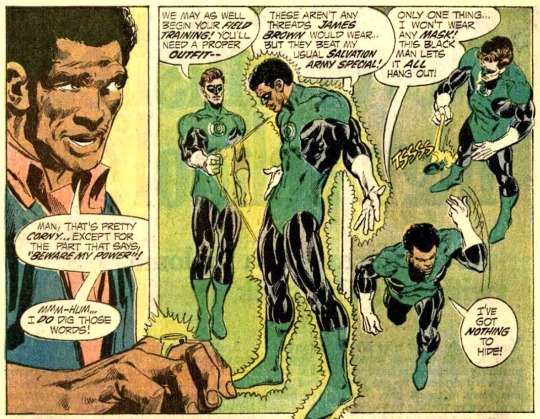
Oh John Stewart, thank god for you.
John was introduced as an explicitly political character in an explicitly political story. The first time we see him, he's stepping in to defend Black men from a white cop, citing his own knowledge of the law to do so. He shows a much more perceptive and informed perspective on the issue's main plot (a racist senator running for president) than Hal does. Even in the little moment above, we see that he's sensitive to exactly what it means for him, a Black man, to be taking on this role.
None of this is a surprise, since we'll later learn that John's parents were civil rights activists. Not only would he not have had the privilege Hal and Guy did to assume his existence was politically neutral, he was explicitly educated about political realities and progressive advocacy from childhood. He's well-informed, he's passionate, and he's going to tell you when you are being fucking stupid.
John isn't immune from the GL cop/military...thing, although I can't blame Johns for that - it was the cartoon that made him a Marine, and the comics followed suit. But that's never outweighed his origin or his upbringing. Like, he's friends with the DCU's fictional version of Nelson Mandela.
This one is straightforward: John is a staunch progressive. He is, however, in outer space 90% of the time, so he's always at least a little bit out of date. I imagine every time he comes back to Earth he spends the first 24 hours watching the news in abject horror.
Kyle:

Kyle doesn't talk about politics a lot, but when he does, he lands pretty much where you'd expect a young California-born artist living in New York City to land: to the left. My read on Kyle is that he hasn't really thought any of his politics through, which makes sense - he's a character who is led by emotion over reason every time. He doesn't have John's carefully thought-through arguments or knowledge of the law behind him. I feel like when something political upsets him, he's more likely to splutter angrily than make a coherent argument (which: same). When he's given the time to think things through and speak from the heart, though, he can be very eloquent, like in his speech to Terry after Terry accidentally comes out to him.
It's also worth pointing out that his solo appearances were mostly in the 90s, which were prone to avoiding politics or only addressing them in a halfhearted both sides-y way like the story above.
That said, I don't think he ever actually does anything about his political opinions. He never votes in midterm or primary elections, and probably only voted in a presidential one because Alex dragged him along one time. I feel like Donna tried to do the same when they were dating and that was when Kyle realized he'd forgotten to change his voter registration from California to New York. Jennie wasn't responsible enough to Mom him into doing his civic duty, and he's been in space pretty much nonstop ever since, so...
Simon:
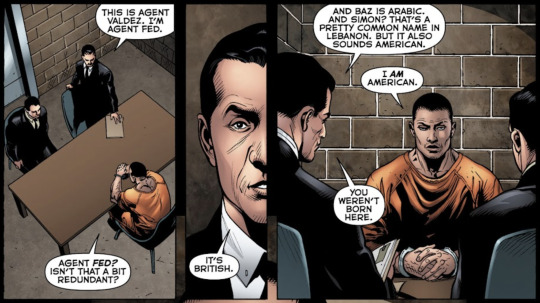
In that other post, I said Simon's experiences should have radicalized him, but instead he was created by Geoff Johns. Simon is a Muslim, Lebanese-American man who came of age in the post-9/11 era, and was wrongfully convicted of terrorism and waterboarded at Guantanamo Bay. His reaction to this was...to put on a ski mask and wave a gun around. Like, it's been a while since I've read these issues, but aside from the "ripped from the headlines!!!" of it all, I feel like Simon's experiences largely don't inform his actions or perspective except that he's super angry (fair enough).
The thing about Simon (and Jessica) is that he hasn't been around very long, and most comics don't have characters directly expressing political opinions. It's not a coincidence that these characters are in chronological order and each write-up is shorter than the last. I can think of about three times where Kyle has ever said anything I can interpret as political, and he's been around for 30 years. Simon only has a third of that history. So while one could certainly extrapolate what Simon's opinions are likely to be, I can't think of any canon where he actually says them.
Jessica:

Jessica has even less to go on in terms of explicitly political comics. You'd think she wouldn't like guns because of what happened to her friends, but she has one of her own and doesn't seem bothered by Simon's. I'd imagine she has opinions on immigration as someone whose family is from Mexico and Honduras, but it never comes up. If I were writing for DC, I'd make both Simon and Jess leftists, but as for actual canon proof? I got nothing.
I will say that she probably avoids political discussions because anxiety, and I bet she got really good at voting by mail during her years not leaving the house. She probably votes by mail from space. Maybe John's not the only one with an up-to-date voter registration.
Kilowog:
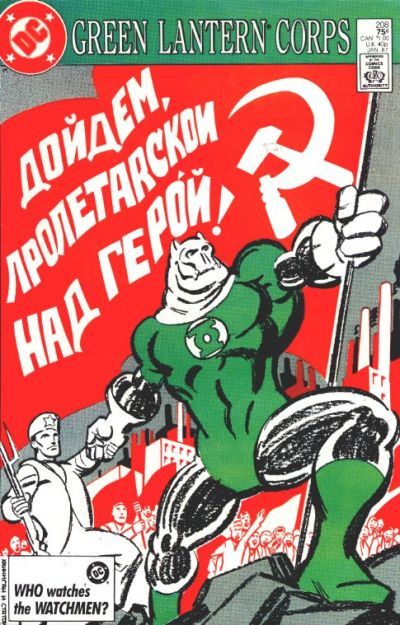
97 notes
·
View notes
Text
Young Americans are more pro-Palestinian than their elders. Why?

Originally posted 12/23/23; updated 12/24/23
This is a thought provoking article about how different U.S. generations perceive the current conflict between Israel and Hamas. To encourage people to read the entire article, this is a gift 🎁link so that anyone can read the article, even if they do not subscribe to The Washington Post.
Although I am from an older U.S. generation, I condemn the Netanyahu administration's decision to pursue Hamas at the unconscionable expense of tens of thousands Palestinian civilians, including many children.
However, reading this article helped me to also understand why, being born in the decade after the Holocaust, I don't absolve Hamas of their terrifying behavior on Oct. 7th--unlike many younger people seem to have done. Although I strongly oppose the apartheid Israel has imposed on the Palestinians (and I do believe that Palestine should have been a free separate state long ago), I still don't think there is any justification for such a terrorist act against Israeli civilians.
I encourage you to read the entire article, but here are a few excerpts:
Across more than two months of war between Israel and Hamas, public opinion on the conflict has continuously shifted. But there has been a constant: a divide between the views of older and younger Americans that has shown up both during the war and in the years leading up to it.
[...]
Each age group has a different “generational memory” of Israel, Dov Waxman,director of the UCLA Younes and Soraya Nazarian Center for Israel Studies, said. Beliefs about the world tend to form in our late teens and early 20s and often don’t change, he said.
Older generations, with a more visceral sense of the Holocaust, tend to see Israel as a vital refuge for the Jews, he said, and see its story as one of a people returning to safety in their homeland after living for 2,000 years as a scattered diaspora facing persistent persecution.
In the decades after its founding, Israel was a relatively lower-income and vulnerable country.
[...]
But by the time millennials began forming their understanding of global events, the violence of the second Intifada had concluded in the mid-2000s with enhanced walls and barriers constructed between Israel and the West Bank, and then Gaza. This generation formed its idea of Israel from reports of Palestinians denied access to water, freedom of movement and fair trials, under the military control of what was by then a relatively rich, nuclear-armed power.
“When I was in college it was the Oslo peace process, and I still remember that Israel — pursuing peace with the Palestinians and the hopes that came along with that,” Waxman said, of the ’90s. “Younger Americans have no memory of that.”
[See more excerpts from the article under the cut. Those excerpts are worth reading because they are quite thought provoking.]
A racial justice lens
Joey Ayoub, a Palestinian-Lebanese writer, podcaster and academic, says young Americans are more likely to conceptualize the Palestinian cause as a sister issue to U.S. efforts for racial justice. There is a “visual parallel,” he said: of an armed soldier or police officer dominating a space inhabited by a populace with limited power, whether in a town in the occupied West Bank or a majority-Black neighborhood in the United States.
[...]
Eitan Hersh, a political science professor at Tufts University, said conflict between Israel and Palestinians seems to be seen by the young left, especially on college campuses, as “a people of color — that is, the Palestinians — rising up against a white oppressor,” though a significant portion of Israel’s Jewish population is of a non-European background. (Some are the descendants of about 850,000 Jews who were expelled from Arab countries and Iran after Israel was founded.)
“It’s a bit of a curiosity,” he said. “One could tell an oppressor-oppressed story where the Jews, and Israel, is a story of the oppressed: kicked out of all these countries, going back to their homeland, surrounded by a broad set of dominant countries in the region that wants to destroy it.”
Shifting demographics
One explanation for the generational divide, experts said, was that fewer Gen Zers and millennials identify as conservative or Christian — demographics more likely to sympathize with Israel — than older groups.
[...]
Another “major factor” in older generations’ feelings toward Israel is their greater religiosity, according to Waxman. More than three-quarters of Americans 60-64 are Christian — with increasingly higher numbers for older brackets — compared with about half of adults under 30.
“It’s, I think, for many religious Christians, somehow a kind of atonement in supporting Israel and Zionism,” Waxman added. “Genuinely, a feeling of Israel as a consequence of this long history of Jewish persecution” by Christians.
Some Christians, particularly among evangelicals who are especially likely to sympathize with Israel, believe that Israel was promised to the Jews by God, and that the return of the Jews to Israel fulfills a biblical prophecy of the events that will precede the second coming of Jesus Christ.
But even outside of this belief, the idea of Israel as a sacred land for Judeo-Christians has an emotional resonance that is simply not present for the increasing number of secular young Americans.
[...]
Social vs traditional media
Dana El Kurd, a nonresident fellow at the Middle East Institute, said different types of media consumption have probably played a role in how people have formed their views on the Middle East.
Americans 45 and older are most likely to get their news from TV networks and their websites, and Americans younger than 45 are most likely to get their news through social media, according to 2022 YouGov polling.
The regular use of TikTok in particular is correlated with criticism of Israel, a New York Times/Siena poll found this week.
Ayoub, whose interview podcast “The Fire These Times” with Lebanese, Palestinian, Syrian, Jewish, and Armenian perspectives has mostly Gen Z and millennial listeners, said that new forms of media facilitated access between content creators and consumers without “having a gatekeeper.” This has downsides, including “a huge uptick in misinformation” online, he said, but also positives, including allowing traditionally underrepresented groups to reach an audience.
[...]
“I’ll give an anecdote,” El Kurd said. “My students, when the war broke out, said that they had gone onto TikTok and toggled between the different locations,” to see what kind of videos were popular in Israel compared with Gaza, the West Bank and other places. “It had never occurred to me before to do that.”
I encourage people to read the entire article.
I am strongly opposed to the apartheid that Israel imposed on the Palestinian population. But being from an older generation, I am also less likely to wholly embrace some of the (in my opinion) more simplistic generalizations that younger generations claim regarding Israel.
For instance, many younger people assume most Israelis are predominantly of white European ancestry, but there is evidence that about half the Israeli population is not of white European descent, including those who always lived in the region, those from Ethiopia and Northern Africa, and the descendants of the 20th century expulsion of 850,000 Jews from other nations in the Middle East.


There are also some estimates that only 20% of the general gene pool in Israel is white European. This in turn leads to questions about the assumption of many younger people that white European Jews engaged in a "settler colonialism" of Israel. Still, some form of colonization DID happen, even if it might not fit a strict definition of "settler colonialism."
But it is important to remember that most of the Jewish colonizers around the time of Israel's founding were refugees who had survived the Holocaust, or were running from Eastern European pogroms/oppression, or who were expelled from Iran and Arab nations. What is tragic is that many of these Jewish victims of persecution and oppression and/or their descendants ended up implementing or supporting oppressive practices towards the Palestinians in their attempts to create a Jewish state where they could finally feel safe.
In many ways, all the nations of the world who oppressed and persecuted Jews for centuries have some responsibility for this mess. But that does not absolve the Israeli leaders from their oppressive choices towards Palestinians (especially their current choices that have resulted in the deaths of tens of thousands of Palestinian civilians)--just as Israeli oppressive behavior does not absolve Hamas leaders for their decisions to employ terrorist tactics against Israeli civilians on Oct. 7th.
Although I still support a two-state solution, I believe there are no easy fixes to this situation. The conflict, for both Israelis and Palestinians is an emotional powder keg fueled by thousands of years of transgenerational trauma (both within the region, and outside it in the case of the Jewish diaspora). This in turn affects the perceptions and responses of both Israelis and Palestinians. Sadly the current conflict has only added a new layer to the transgenerational trauma of both groups.
Anyway, after reading the above article, I realize that coming from an older generation, my perspective on the Israeli-Hamas conflict is different than the perspectives of some younger people. However, I still think there should be an immediate cease fire, and that the Biden administration should STOP supporting Israel, unless Israelis agree to end the fighting, fully support a rapid international humanitarian aid effort for the Palestinians in Gaza, come to the table to negotiate peace, and finally allow the creation of a free Palestinian state.
Originally posted 12/23/23; updated 12/24/23
#israel hamas conflict#generational differences in perception#israel#gaza#palestinians#frances vinell#the washington post#gift link
114 notes
·
View notes
Text
*LONG POST WARNING*
What your favourite New Who Companion says about you (absolutely no offence meant towards anyone, this is just for fun):
Rose: Either the most vanilla person alive, or an RTD era purist. Has spent years fighting for the honor of the RTD era. Ships Ten and Rose to the degree that they shudder at the thought of the Doctor having a relationship with someone else. Is constantly at war with Amy stans. Part of the reason for the RTD enjoyer vs Moffat fan civil war. Usually nice in real life, and quite nostalgic for the Tennant era, so usually OK to be friends with. Unless they say Mickey was treated fairly, at which point, you should run.
Mickey: One of the most kind-hearted, empathetic people, who saw how Mickey was mistreated by Rose in S2 and immediately just wanted to check if he was OK. Is able to hold decent relations with Rose stans due to Mickey's character development after the relationship, and has a surprisingly strong alliance with Rory fans. Was gutted when they heard about Noel Clarke's horrible behaviour and actions.
Adam: Let's be real, we all forgot this guy existed and for good reason.
Captain Jack: Every night, they lie in bed, haunted by the ghost of Torchwood. Loved seeing Jack again in S12, but felt disappointed after his lack of presence in Revolution of the Daleks. Has modelled several aspects of their personality on the Captain, and has the dating life (or lack thereof) to prove it. Cried at the deaths of Ianto and John Barrowman's career.
Martha: Basically Rose fans, except with slightly more indie music taste. Either that, or a person who knows how integral Martha is to 10's character arc. Has attempted to defend the "Space Jesus" scene a couple of times, and cried with happiness when Harbo Wholmes said that it worked in his review. Has a bit of a patchy relationship with Rose stans due to the Doctor's rebound arc, gets along better with Donna stans due to the fact that S4 acknowledged that 10 mistreated Martha. Generally has good taste and is nice to be around, just don't mention how undeveloped her relationship with Tom was.
Donna: Either a child of the late 90s/early 2000s who had the joy of watching New Who at it's peak in 2008, a person who really appreciates great character writing and an excellent series, or someone who just wanted a break from the companion having a romantic subplot. Often gets into heated arguments with Amy stans by (correctly) saying that Series 4 was better than Series 5. Uses Donna's funny dialogue and quips to hide the fact they are still recovering from one of the cruellest companion exits in the show. Generally nice, but very defensive of The Doctor's Daughter.
Wilf: I love these guys. Knows that a) Wilf is the single best character in the entirety of New Who and b) he counts as a companion. Has the best possible taste, and is an absolute joy to be around as a result of it. An emotional wreck after every single rewatch of The End of Time, especially now that the legendary Bernard Cribbins has left us. Has excellent relations with Donna stans, and was similarly overjoyed when they heard about the 60th. Refuses to admit that The End of Time would have possibly worked better as a 90 minute special.
Amy: Definitely has followed the eons-old teaching of "gaslight, gatekeep, girlboss" at some point. Refuses to admit A Good Man Goes to War was mid and that Amy really badly mistreated our sweet prince Rory in a large chunk of S5. Is really happy that Karen Gillan made it big in Hollywood. Friendly unless you say you prefer Rose to Amy. Could not be comforted after that cameo in Time of the Doctor.
Rory: Their favourite episode is usually The Girl Who Waited. Loyal, friendly, introverted and lovable, they of course identify with Rory's slightly long-suffering but accepting and funny character. Understandably annoyed at how Amy mistreated Rory in S5, but happy that S6 & 7A fixed that marriage. Thanks to Rory waiting for 2000 years, their bar for any personal relationship has been set insanely high. Celebrated when the BBC actually allowed Arthur Darvill to style his hair in S7A. Had to check Rory was definitely dead at the end of Angels Take Manhattan due to Moffat killing him whenever more tension was needed in a story.
River Song: Divided into two groups. Those who like River Song's more nuanced appearances in Silence in the Library, A Good Man Goes to War and The Husbands of River Song are awesome. Those who prefer the episodes that Moffat wrote with one hand, less so. Was overjpyed to see the Moffat Era reappraisal of 2020, only to be slightly disappointed when people said S6 was his weakest series. Wierdly enough, gets along nicely with all other companion stans. Has definitely said "Hello sweetie" to their partner/partners/friends/pets. If they prefer 12 and River to 11 and River, pass them the aux on a long journey (trust me on this one).
Clara: From my personal experience, there is a 60% chance that they are a closeted bisexual. Doesn't get why Clara was so overhated, especially in S9. Is wierdly OK with admitting that Victorian Clara was slightly more interesting to begin with, but knows that the character worked so well in 12's era. If they ship 11 and Clara, keep an eye on them. They haven't fully earned your trust yet.
Bill: Heterosexuality was never an option. Gets along well with Clara stans, as they both know how much the 12th Doctor's era s l a p p e d. Had their emotions mangled during the S10 finale, but fortunately came out intact thanks to that puddle and a happy-ish ending. Loved that Bill called 12 out on his bullshit and asked all the trivial questions we were all thinking. Singlehandedly drove the Moffat Era reappraisal over quarantine. Has the best fashion sense out of all the stans.
Nardole: A terrifying enigma. Looked at all the companions with complex stories, interesting arcs and major development, but instead went with the comic relief. Yes, Nardole is funny and a great support character, but... er... how? They can be nice. They can also be fans of Little Britain, which is a red flag. It's a roll of the dice.
Graham: Bradley Walsh was the highlight of the slightly undervalued S11, and they know it. Definitely has the vibe of being 10+ years older than they actually are in terms of attitude, but in the best way. Has definitely owned a pair of cords in their life. Goes into Doctor Who just looking for a fun hour of entertainment rather than lore. Great to hang out with. They always bring snacks.
Ryan: Tries to ignore the fact that Ryan has the most fucking insulting depiction of dyspraxia in any form of media (sorry, I have dyspraxia, and the way it was treated in S11 & 12 just really rubbed me the wrong way), but is also helpful and really in favour of spreading awareness. We're cool for now.
Yaz: One of the nicest, most well-intentioned people you will ever meet, always defending the underdog, supporting others and just being sweeter than a tea with six sugars, but also a master of illusion. Has read so many fan fictions, seen so much fan art and shipped Thasmin so much that they have tricked themselves into thinking Yaz is a three-dimensional, well-written character whose story was not completely made up on the go by Chibnall. Little more than a defeated husk after Power of the Doctor, being rewarded for all those years of fanfics, shipping and defending the era with a couple of longing stares and some hastily written "will they/won't they" scenes before 13 unceremoniously booted Yaz out of the TARDIS. Thinks Demons of the Punjab is the best 13 episode when it is really The Haunting of Villa Diodati.
Dan: Is more of a fan of John Bishop and his charisma than they are a fan of Dan, or is a terminally online person who thinks quoting "Evil Dan" videos makes them the funniest human alive (it really doesn't).
Want more of this for some reason? Try your Favourite Doctor or Favourite Master
#doctor who#doctor who meta#doctor who memes#rose tyler#martha jones#donna noble#wilfred mott#doctor who funny#amy pond#rory williams#river song#clara oswald#bill potts#nardole#graham o'brien#ryan sinclair#don't you dare#thasmin#thirteen x yasmin#dan lewis#rtd era#moffat era#chibnall era#ninth doctor#tenth doctor#eleventh doctor#twelfth doctor#thirteenth doctor#doctor who companions#long post
799 notes
·
View notes
Text
Feel free to share which is your favorite NOW in the tags, but this particular poll is about which you preferred as a child! ⭐ These are being grouped by a vague theme, so in a few days we'll do another one with more options!
Also, same rule as the last poll: REALLY popular choices (ATLA, SpongeBob, Scooby Doo, Pokemon, etc.) are overwhelmingly popular and have been omitted for the sake of seeing the results for other shows. Arthur and The Magic School Bus fit today's category but have been intentionally omitted for this reason. <3
The timeframe for these polls is generally "I was a kid in the mid-to-late 90s or early 2000s." Again, we do two of these polls a week, so if you don't see your favorite choice it may be in a different poll! I can only add so many options at a time :)
251 notes
·
View notes